- Skip to main content
- Keyboard shortcuts for audio player

Chinese families navigate a maze of laws and COVID rules to have babies in the U.S.

FOUNTAIN VALLEY, California — Inside a three-story pastel mansion in this quiet suburb south of Los Angeles, Auntie Wang cradles a 2-week-old baby girl named Echo.
"The more time you spend with her, the more she is attached to you," says Auntie Wang, who moved to the United States seven years ago from China. "You hold her, play with her, engage with her and look, she responds to you."
The 58-year-old clucks and coos at the baby in obvious delight. But for all the affection, she is not the baby's mother or even a relative. She is a hired nanny whose job is to care for Echo and other babies like her born through surrogacy — where a woman carries and gives birth to a baby for another couple or individual.
Auntie Wang does not want to share her full name because of the sensitivity and legal issues around surrogacy in her home country.
The agency she works for, called Fat Daddy, specializes in these services for clients in China — where providing surrogacy is effectively prohibited.
The company is one part of a well-established industry centered in California that also includes the controversial service of bringing Chinese mothers to the U.S. to give birth to their children, known as "birth tourism."
But for nearly three years, the whole industry has been upended by the coronavirus pandemic and China's travel restrictions, which have been among the tightest in the world. In 2020, Beijing completely shut the country's border to contain COVID-19 and has never fully reopened them.
That has meant Chinese parents cannot fly to the U.S. to meet or vet their surrogate in person. Instead, clients have had to send their reproductive samples — eggs, sperm or both — via special delivery to the U.S. so the surrogacy can take place.
China's "zero-COVID" policies and recent passport restrictions have also made it nearly impossible for many Chinese parents to then travel to the U.S. to pick up their newborn babies.
So, for nannies like Auntie Wang, that has meant a lot more work. Whereas before the pandemic, she looked after the babies for up to six weeks, now such care often stretches to several months while the Fat Daddy agency works to arrange flights and the Chinese residency papers required to transport the babies to China.
They're coming to America, where surrogacy is legal in most states
One family caught up in the bureaucracy is 1-year-old Lucy, born in the U.S., and her parents back in China.
"Getting a [U.S.] visa took Lucy's mother four months," explains Sunny, a Fat Daddy employee who manages the house where surrogate babies and their caretakers live. She wants to use only her first name in the story to avoid being identified because providing surrogacy is illegal in China. "But her flights from China keep getting canceled."

In the U.S., Chinese couples can easily pay more than $100,000 for surrogacy — high costs that include lodging, catering and transportation.
Cheaper options exist in Thailand , Cambodia, India and Russia. In recent years, Ukraine had become a major center for the industry, but after Russia invaded the country, at least 19 surrogate babies destined for China were left stranded .

A rescue team evacuates premature American twins from Kyiv in a daring mission
Rather than look abroad, some Chinese parents seek surrogacy services from underground providers in China. One study estimates that a decade ago, up to 500 businesses were operating surreptitiously.
But people using the services had few legal rights if the provider did not hand over the baby — or if the biological parents decided to split custody .
For Chinese parents with the financial means, a popular option remains the U.S., where surrogacy is legal in most states.
"America has everything. America is a good country — as long as you know what you want," says one Chinese birth tourism agent based in California. He does not want to give his name because China bans providing such services. "Having children in the U.S. will always bring advantages, because America is a country for immigrants."
It is difficult to know how many Chinese couples use surrogacy services in California because the state's health department says it does not keep track. But NPR spoke to several agencies that suggested there were hundreds, if not thousands of cases in the state a year.
The co-founder of Fat Daddy, Zheng, says there are many reasons clients want to use his company's services.

Coronavirus Live Updates
Surrogate-born babies wait in ukraine amid coronavirus travel restrictions.
He says China used to limit couples to just one child (now the limit is three ), so wealthy couples used to have their second or even third child in the U.S. Another reason is that unmarried women and non-heterosexual couples often have a hard time having children or adopting legally.
Having a baby, even via surrogate in the U.S., also grants the child coveted American citizenship. Perhaps surprisingly, Zheng says the growing competition between the U.S. and China has actually made American citizenship more attractive to many families.
"In the foreseeable future, China and the U.S. will definitely be the two strongest countries in the world," he says. "If the U.S. is not the first, then China will be and it will definitely be a win-win situation for your children in the future if they have both these nationalities."
Before the pandemic, Zheng says, Chinese demand for surrogacy and birth tourism services was so high he used to rent out entire apartment buildings for Chinese families.
And according to another agent — who only gave her name as Lulu for fear of retribution for speaking frankly about Chinese politics and surrogacy — many of her clients were "high-level Communist Party officials and celebrities" with money and power who wanted their children to have American citizenship. In China it is illegal for citizens to be dual nationals.
Some are going for DIY birth tourism
Only the most determined of prospective Chinese parents are trickling into the U.S. these days.
One of them is Lily, a lawyer from Baotou, Inner Mongolia. She does not want to use her full name because the issue of birth tourism is sensitive in China.
Lily is doing what the industry calls a DIY — do-it-yourself — birth tourism experience; renting her own house and hiring a full-time nanny to look after her toddler Gordon, who was born in the U.S.
When NPR met Lily in May, she was pregnant with a second child. The family planned to spend another six months in the U.S. after the birth before returning home.
"There are all-around advantages in the U.S.; freedom of speech, a sense of security," she says, explaining her decision. "My child is definitely better off if they have these options."
She also half-jokes that she also came to the U.S. because she wanted a pain-free birth. "It is difficult to get full epidurals in China!" she says.
But many aren't as lucky as Lily. Parents using surrogacy will have a long wait before they can see their babies.

Now many of the babies are flown back to China under the supervision of a dedicated nanny provided by the agencies.
For Auntie Wang, seeing the babies she's looked after for many months is always a hugely emotional moment.
"Oh, we cry when we say goodbye to these children! It is painful to part with them. They're like our own," says Auntie Wang. "It is like this for all the nannies. After even just a month you have an emotional bond with them."
- birth tourism
- Personal Injury Practice Areas
- Construction Accidents
- Motor Vehicle
- Bus Accident
- Truck Accident
- T-Bone Accident
- Train Accident
- Hit And Run
- Pedestrian Accident
- Rollover Accident
- Slip & Fall
- Nursing Home Negligence
- Medical Malpractice
- Wrongful Death
- Product Liability
- Bicycle Accident
- Drunk Driver
- Burn Injury
- Birth Injury
- Uber Accident
- Case Studies

- Immigration Immigration Services
- Citizenship & Naturalization
- Employment Immigration
- Deportation and Removal Defense
- Family Immigration
- Investor Visa
- Marriage-Based Visa
- Immigration Mandamus Litigation
- Asylum & Refugee Protection
- Nonimmigrant Visas
- Student Visa
- Fiance Visa
- Success Stories

- Brad Show Live
- Legal Insights
- Get In Touch
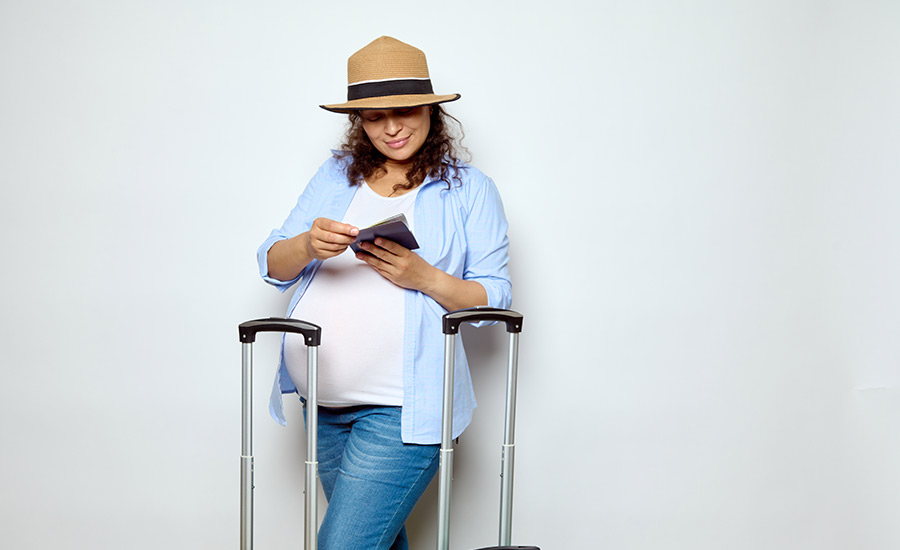
Giving Birth In The US On A Tourist Visa: A Detailed Guide
Each year, the United States become birthplace of 33,000 babies while their mothers visit the country as tourists — on top of hundreds of thousands more born by women on temporary visas and illegal aliens.
This alarming statistic has led to legal changes for giving birth in the U.S. on a tourist visa.
We’ll explain what birth tourism is and cover the legal consequences of having your baby in the U.S. as a tourist. We’ll also share the most recent legislation updates regarding tourist visas for pregnant women.
Contact Spar & Bernstein
Table of Contents
This article was written and reviewed by Bradford H. Bernstein, a second-generation leader at Law Offices of Spar & Bernstein, P.C., who has helped over 100,000 clients with immigration and personal injury issues. Brad joined the firm in 1993, became a partner in 1997, and assumed leadership in 2000 after Harry Spar retired.

What Is Birth Tourism?
Birth tourism is the practice of traveling to another country, specifically to give birth in that country. Birth tourism often occurs on a temporary visa, such as a tourist visa.
Considered one of the best countries to give birth in, the U.S. is an attractive place for birth tourism. The motivation behind birth tourism in the U.S. includes:
- Perceived stability : Accepted as a stable and prosperous country, the U.S. is an attractive place to give birth and raise a child.
- Citiznship benefits : Giving birth in the U.S. makes your child a U.S. citizen, which gives the child access to education, healthcare and potential career opportunities.
- Family reunification: Giving birth in the U.S. can be used as a pathway for you and your spouse as a U.S. citizen’s parents to obtain legal immigration status in the U.S.
However, birth tourism in the U.S. is viewed as a potential threat to national security , because:
- It can lead to the fraudulent acquirement of U.S. citizenship, bypassing the traditional immigration pathways and security screening procedures
- It can strain healthcare and public services, impacting the well-being and security of citizens and legal residents
As a result, birth tourism has provoked numerous discussions about tightening regulations to ensure that those who enter the U.S. come to the country for legitimate reasons and are not compromising national security.
What Happens If You Give Birth In The US On A Tourist Visa?
Giving birth in the U.S. on a tourist visa can have certain legal consequences for both mother and child.
1. Legal Implications For The Mother
Giving birth in the U.S. on a tourist visa does not automatically grant you the right to stay in the country based on the birth of your child.
Your visa status remains unchanged and you will be typically expected to leave the U.S. before your visa expires. If you do not leave the country after the expiration of your visa, this will be considered as overstaying a visa , which may result in future travel restrictions or challenges when applying for a visa for subsequent visits.
In addition, if your primary purpose for entering the U.S. was to give birth and you did not truthfully represent your intentions to immigration officials, you can be charged with visa fraud due to willful misrepresentation of a material fact (that you were planning to have your baby in the U.S.) or face visa denial for future visa applications, due to credibility concerns.
While giving birth in the U.S. does not directly grant you any type of immigration status, there may be pathways that can help you remain in the U.S. permanently.
These alternatives can include family-sponsored visas, employment-based visas or other immigration categories. Talk to an experienced immigration attorney to understand your options.
2. Legal Implications For The Child
If your child is born on U.S. soil, they will acquire U.S. citizenship through the principle of jus soli (birthright citizenship).
- In addition to citizenship, being born in the U.S. allows your child to:
- Apply for a U.S. passport
Hold dual citizenship, depending on your home country’s laws
Apart from benefits, however, U.S. citizenship also comes with certain obligations. If your child is born in the U.S. and therefore is a U.S. citizen, your child is likely to:
- Have residency obligations, such as potential taxation on global income and the need to enter and exit the U.S. using a U.S. passport
- Face immigration challenges, as they may need to navigate U.S. immigration regulations, even if they choose not to reside in the U.S.
Because each situation is unique, the legal implications can vary based on the specific circumstances. We recommended seeking professional advice from a reputable immigration law firm, like The Law Offices of Spar & Bernstein.
With five decades of immigration experience, our team at The Law Offices of Spar & Bernstein has supported thousands of people in various immigration situations, from getting married on a tourist visa or navigating a visa overstay to removing conditions on a Green Card and facing the challenges of divorce after Green Card .
Schedule a consultation with our caring and tenacious team for professional guidance and advice in your situation. We will explain the legal implications for yourself and your child and share our advice on next steps.
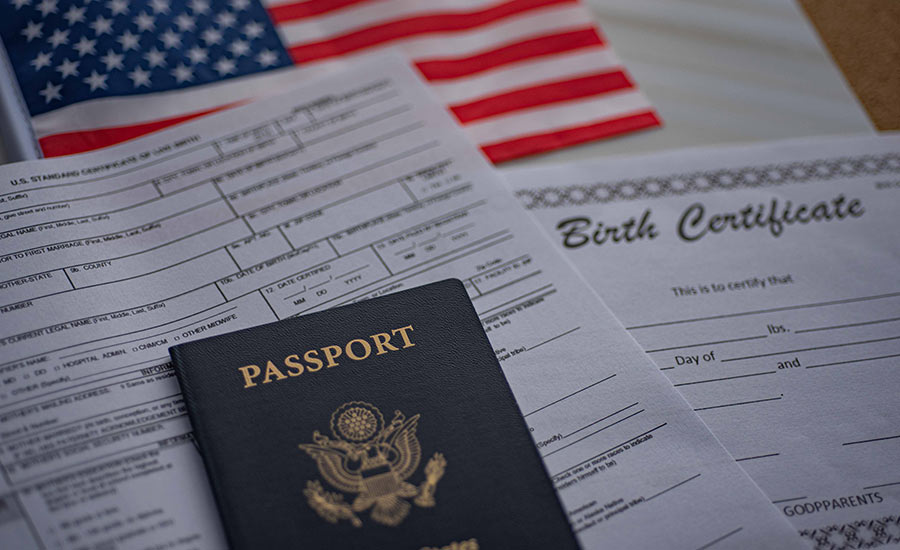
New Rules For Giving Birth On A Tourist Visa In The US
As per the U.S. government, traveling to the U.S. and giving birth with the intention to obtain U.S. citizenship for your child is not an acceptable reason for granting a B nonimmigrant visa.
According to the updated temporary visa regulations , which became effective as of January 22, 2020, the consular officers have the authority to deny a B nonimmigrant visa to individuals they believe intend to travel solely for the purpose of obtaining U.S. citizenship for their child through birth.
However, the U.S. government recognized that foreign nationals may wish to travel to the U.S. for medical treatment while pregnant , which is different from birth tourism.
If you need to visit the U.S. for medical treatment while pregnant, you must submit your visa application along with:
- A legitimate reason to travel to the U.S. for medical treatment, such as a condition requiring specialized medical expertise, availability of advanced medical technology, chronic disease management, participation in a trial or experimental treatments that are not available in your country, or seeking a second opinion
- A confirmation by a medical practitioner or facility stating that they agreed to provide treatment
- An estimated duration of stay in the U.S.
- A projected cost of treatment
- Proof that you can cover your medical treatment, transportation and living expenses, either on your own or with pre-arranged assistance from other parties
The new rule restricting tourist visas to pregnant women does not affect :
- F-1 academic visa applicants
- M-1 vocational student visa applicants
- H1-B work visa applicants
- Those seeking lawful permanent residence in the U.S.
If you are considering visiting the U.S. on a tourist visa, especially if you are pregnant, talk to legal experts to review the latest updates and get professional recommendations on next steps.
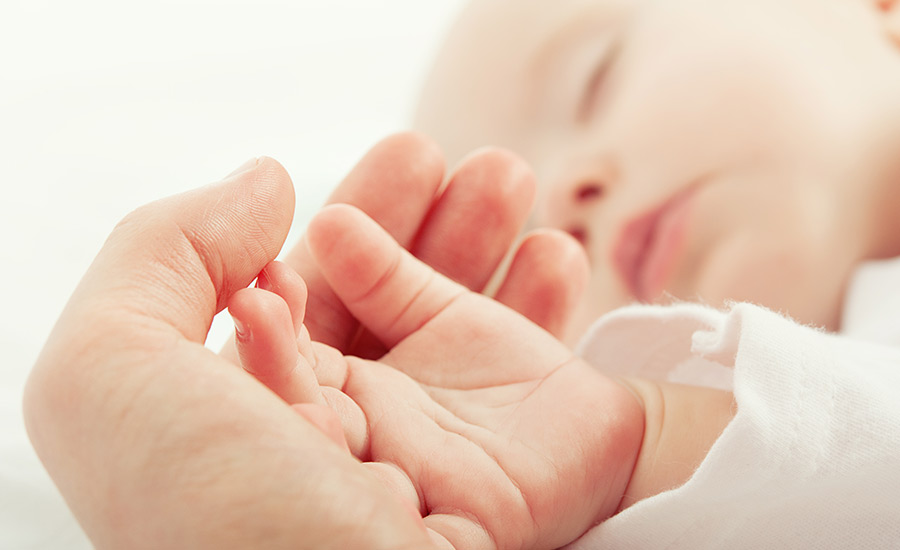
Need Legal Advice? Contact Spar & Bernstein
With a long-standing history and commitment to serving clients with care and compassion, our experienced team at The Law Offices of Spar & Bernstein provides a guiding hand in key areas of immigration, from nonimmigrant visas and marriage-based visas to family immigration and waivers .
Giving birth in the U.S. on a tourist visa can be extremely overwhelming. To help you in this life-changing situation, our knowledgeable and compassionate lawyers will:
- Provide personalized advice based on your specific situation
- Assess your visa status
- Explain your rights and obligations as a foreign national in line with the changing policies and regulations that might affect your situation
- Provide insight into the implications of U.S. citizenship for your child
- Explore various legal options for you and your child, such as addressing potential overstays, adjusting your visa category or seeking pathways for obtaining legal immigration status
- Review your documentation to ensure accuracy and compliance with immigration regulations
- Submit your application for extending your stay or changing your visa category, along with all necessary documents
- Handle the communication with immigration officials on your behalf
- Represent you and advocate on your behalf in case of visa denial, overstay issues or other problems
- Provide peace of mind while you focus on caring for and bonding with your child
With Spar & Bernstein, you can rest assured that you and your child are in good hands.
Schedule a consultation
Giving Birth In The US On A Tourist Visa: Key Takeaways
Giving birth in the U.S. on a tourist visa can have a number of legal implications for both you and your child.
You will likely be denied a visa if your intentions to travel to the U.S. are only related to birth and the potential benefits that offers.
However, you can still be eligible for a visa if your medical condition requires treatment in the U.S. and you are expecting a child.
If you have questions about birth tourism or need to get a visa for medical treatment in the U.S. while pregnant contact our experienced and compassionate immigration lawyers at Spar & Bernstein.
We will help you navigate this complex situation by taking care of all the documents and procedures needed to maintain your legal status and pursue pathways to maintain in the country, if desired.
Work with our immigration attorneys
Security Alert May 17, 2024
Worldwide caution, update may 10, 2024, information for u.s. citizens in the middle east.
- Travel Advisories |
- Contact Us |
- MyTravelGov |
Find U.S. Embassies & Consulates
Travel.state.gov, congressional liaison, special issuance agency, u.s. passports, international travel, intercountry adoption, international parental child abduction, records and authentications, popular links, travel advisories, mytravelgov, stay connected, legal resources, legal information, info for u.s. law enforcement, replace or certify documents.
Tourism & Visit
Study & Exchange
Other Visa Categories
U.S. Visa: Reciprocity and Civil Documents by Country
Visa Information & Resources
Share this page:
Rights and Protections for Temporary Workers - Japanese
Rights and Protections for Temporary Workers - Turkish
Rights and Protections for Temporary Workers - Hebrew
Rights and Protections for Temporary Workers - Albanian
Rights and Protections for Temporary Workers - Tagalog
Rights and Protections for Temporary Workers - Russian
Rights and Protections for Temporary Workers - Polish
Rights and Protections for Temporary Workers - Ukranian
Visa Wizard
Visa Denials
Fraud Warning
What the Visa Expiration Date Means
Automatic Revalidation
Lost and Stolen Passports, Visas, and Arrival/Departure Records (Form I-94)
Directory of Visa Categories
Straight Facts on U.S. Visas
Customer Service Statement
Photo Requirements
Photo Examples
Digital Image Requirements
Photo Frequently Asked Questions
Photo Composition Template
Online Immigrant Visa Forms
DS-260 Immigrant Visa Electronic Application - Frequently Asked Questions (FAQs)
DS-160: Online Nonimmigrant Visa Application
DS-160: Frequently Asked Questions
Administrative Processing Information
Visa Appointment Wait Times
Nonimmigrants in the United States–Applying for Visas in Canada or Mexico
Frequently Asked Questions
Visa Applicants - State Sponsors of Terrorism Countries
What is a U.S. Visa?
About Visas - The Basics
Rights and Protections for Foreign-Citizen Fiancé(e)s and Spouses of U.S. Citizens and Spouses of Lawful Permanent Residents
Your Rights and Protections
Ineligibilities and Waivers: Laws
Rights and Protections for Temporary Workers
Advisory Opinions
Fees for Visa Services
Treaty Countries
Fees and Reciprocity Tables
Temporary Reciprocity Schedule
Country Acronyms
Reciprocity: What's New? 2019 Archive
Reciprocity: What's New? 2022 Archive
Reciprocity: What's New? 2020 Archive
Reciprocity: What's New? 2021 Archive
Reciprocity: What's New?
Reciprocity: What's New? 2023 Archive
Safety & Security of U.S. Borders: Biometrics
National Visa Center Customer Service Pledge
Americans Traveling Abroad
The United States and China Agree to Extending Visas for Short-term Business Travelers, Tourists, and Students
Special Visa Processing Procedures Pursuant to Section 306
Capitalizing on Visa Demand to Spur Economic Growth in the United States
Congressional Testimony
Cuban Family Reunification Parole (CRFP) Program Appointments
List of U.S. Embassies and Consulates - K1-K3 Visas
U.S. Government Fact Sheet on Female Genital Mutilation or Cutting (FGM/C)
Skill List by Country
Presidential Proclamation 9645 and the January 2020 Presidential Proclamation
Public Inquiry Form
List of U.S. Embassies and Consulates
Affidavit of Support Fee Refund
Immigrant Visa Prioritization
USCIS Extends Suspension of Premium Processing Service for Religious Workers (R-1) Nonimmigrant Visa Classification
Record Numbers of U.S. Students Are Studying Abroad
U.S. Student Visas Reach Record Numbers in 2007
U.S. security officials will begin scanning all 10 fingerprints of most non-Americans traveling to the United States
Electronic Submission of Diversity Visa Lottery Applications
USCIS Centralizes Filing for H-2A Petitions
USCIS Field Office Adopts Teletech Call Appointment System For Filing Waiver of Inadmissibility Applications
Application Fees for Non-Immigrant Visas to Increase on January 1, 2008
Senior Advisors to Brief Press on the Latest Developments in Iraqi Refugee and Special Immigrant Visa Issues
Briefing on Developments in the Iraqi Refugee and Special Immigrant Visa (SIV) Admissions Programs
DHS Proposes Changes to Improve H-2A Temporary Agricultural Worker Program
Testimony of Stephen A. “Tony” Edson on U.S. House of Representatives, Committee on Science and Technology Subcommittee on Research and Science Education, House Committee on Science and Technology
Update: Biometric Changes for Re-entry Permits and Refugee Travel Documents
With All the Talk about Illegal Immigration, a Look at the Legal Kind
Latvia, Estonia Sign Deals with US on Visa-Free Travel
Fact Sheet: Changes to the FY2009 H-1B Program
USCIS Announces Interim Rule on H-1B Visas
USCIS Releases Preliminary Number of FY 2009 H-1B Cap Filings
USCIS Extends Comment Period for Proposed Change to H-2A Program
USCIS Runs Random Selection Process for H-1B Petitions
17-Month Extension of Optional Practical Training for Certain Highly Skilled Foreign Students
DHS Begins Collecting 10 Fingerprints from International Visitors at Hartsfield-Jackson Atlanta International Airport
Hague Convention on Intercountry Adoption Enters into Force
USCIS to Accept H-1B Petitions Sent to California or Vermont Service Centers Temporary Accommodation Made for FY 09 Cap-Subject H-1B Petitions
USCIS Revises Filing Instructions for Petition for Alien Relative
USCIS Announces Update for Processing Petitions for Nonimmigrant Victims of Criminal Activity
USCIS to Allow F-1 Students Opportunity to Request Change of Status
Immigration Tops Agenda at North American Summit
USCIS Issues Guidance for Approved Violence against Women Act (VAWA) Self-Petitioners
USCIS Modifies Application for Employment Authorization Previous Versions of Form I-765 Accepted until July 8, 2008
Overseas Education More Attainable for Chinese Students
New York Business Group Seeks Fewer Restrictions on Foreign Worker Visas
Birth Tourism Update
Effective January 24 , the Department is amending its B nonimmigrant visa regulation to address birth tourism. Under this amended regulation, U.S. consular officers overseas will deny any B visa application from an applicant whom the consular officer has reason to believe is traveling for the primary purpose of giving birth in the United States to obtain U.S. citizenship for their child. Please visit the Federal Register website for additional information.
Immigrant Visa Interview-Ready Backlog Report
Global Visa Wait Times
Rights and Protections for Temporary Workers - English
Rights and Protections for Temporary Workers - French
Rights and Protections for Temporary Workers - Spanish
Rights and Protections for Temporary Workers - Portuguese
Rights and Protections for Temporary Workers - Mandarin
Rights and Protections for Temporary Workers - Arabic
Rights and Protections for Temporary Workers - Italian
Rights and Protections for Temporary Workers - German
Rights and Protections for Temporary Workers - Vietnamese
Rights and Protections for Temporary Workers - Romanian
Rights and Protections for Temporary Workers - Korean
Rights and Protections for Temporary Workers - Armenian
Rights and Protections for Temporary Workers - Bulgarian
Rights and Protections for Temporary Workers - Czech
Rights and Protections for Temporary Workers - Hungarian
Rights and Protections for Temporary Workers - Indonesian
Rights and Protections for Temporary Workers - Lithuanian
Rights and Protections for Temporary Workers - Serbian
Rights and Protections for Temporary Workers - Thai
Rights and Protections for Temporary Workers - Mongolian
Rights and Protections for Temporary Workers - Kurdish
External Link
You are about to leave travel.state.gov for an external website that is not maintained by the U.S. Department of State.
Links to external websites are provided as a convenience and should not be construed as an endorsement by the U.S. Department of State of the views or products contained therein. If you wish to remain on travel.state.gov, click the "cancel" message.
You are about to visit:
- Election 2024
- Entertainment
- Newsletters
- Photography
- Personal Finance
- AP Investigations
- AP Buyline Personal Finance
- AP Buyline Shopping
- Press Releases
- Israel-Hamas War
- Russia-Ukraine War
- Global elections
- Asia Pacific
- Latin America
- Middle East
- Election Results
- Delegate Tracker
- AP & Elections
- Auto Racing
- 2024 Paris Olympic Games
- Movie reviews
- Book reviews
- Personal finance
- Financial Markets
- Business Highlights
- Financial wellness
- Artificial Intelligence
- Social Media
US imposes visa rules for pregnant women on ‘birth tourism’

FILE - In this Sept. 2017 file photo, a flag is waved outside the White House, in Washington. The Trump administration is coming out with new visa restrictions aimed at restricting a practice known as “birth tourism.” That refers to cases when women travel to the United States to give birth so their children can have U.S. citizenship. (AP Photo/Carolyn Kaster)
- Copy Link copied
WASHINGTON (AP) — The Trump administration is imposing new visa rules aimed at restricting “birth tourism,” in which women travel to the United States to give birth so their children can have U.S. citizenship. The regulations, which take effect Friday, address one of President Donald Trump’s main political priorities.
The regulations seek to chip away at the number of foreigners who take advantage of the constitutional provision granting“birthright citizenship” to anyone born in the United States, a particular peeve of Trump’s. Under the new rules, pregnant applicants will be denied a tourist visa unless they can prove they must come to the U.S. to give birth for medical reasons and they have money to pay for it or have another compelling reason — not just because they want their child to have an American passport.
Officials said that consular officers will not be asking all female visa applicants of child-bearing age whether they are pregnant or intend to get pregnant. Rather, they said consular officers would ask the question only if they had reason to believe the applicant is pregnant and likely or planning to give birth in the U.S.
Visual cues such as appearing to be pregnant or listing “medical treatment” as a reason for wanting to travel to the United States might trigger such questioning, the officials said. Even if a woman is found to be pregnant and likely to deliver her child in the United States, she could still be granted a visa if she was able to demonstrate a valid reason for the travel such a visiting an ailing relative or attending a business meeting or conference, they said.
Officials said the rule will not apply to foreign travelers coming from any of the 39 mainly European and Asian countries enrolled in the Visa Waiver Program, which allows citizens of those countries to come the U.S. without a visa for temporary stays. The rule will only apply to applicants for so-called “B” class visas that permit short-term stays for business or pleasure.
“Closing this glaring immigration loophole will combat these endemic abuses and ultimately protect the United States from the national security risks created by this practice,” White House press secretary Stephanie Grisham said in a statement. “It will also defend American taxpayers from having their hard-earned dollars siphoned away to finance the direct and downstream costs associated with birth tourism. The integrity of American citizenship must be protected.”
The practice of traveling to the U.S. to give birth is fundamentally legal, although there are scattered cases of authorities arresting operators of birth tourism agencies for visa fraud or tax evasion. And women are often honest about their intentions when applying for visas and even show signed contracts with doctors and hospitals.
The State Department “does not believe that visiting the United States for the primary purpose of obtaining U.S. citizenship for a child, by giving birth in the United States — an activity commonly referred to as ‘birth tourism’ — is a legitimate activity for pleasure or of a recreational nature,” according to the new rules, which were published Thursday in the Federal Register.
Birth tourism is a business where companies for a steep fee offer foreign women the chance to come the U.S. on a tourist visa, have a baby, get medical care, get citizenship, have a place to stay with their newborn, and then leave. It’s distinct from what Trump and his allies deride as “anchor babies,” referring to poor women who enter the U.S. illegally at the U.S.-Mexico border to give birth to a child and then stay in the U.S. illegally. But the end result is the same: a coveted U.S. passport.
The Trump administration also has turned away pregnant women coming over the U.S.-Mexico border as part of a broader immigration crackdown. Those women were initially part of a “vulnerable” group that included others like small children who were allowed in, while tens of thousands of other asylum seekers have been returned to Mexico to wait out their cases.
The Trump administration has been restricting all forms of immigration, but the president has been particularly troubled by birthright citizenship. Trump has railed against the practice and threatened to end it, but scholars and members of his administration have said it’s not so easy to do.
Birth tourism is a lucrative business in both the U.S. and abroad. Companies take out advertisements and charge up to $80,000 to facilitate the practice. Many of the women travel from Russia and China to give birth in the U.S.
The U.S. has been cracking down on the practice since before Trump took office.
“An entire ‘birth tourism’ industry has evolved to assist pregnant women from other countries to come to the United States to obtain U.S. citizenship for their children by giving birth in the United States, and thereby entitle their children to the benefits of U.S. citizenship,” according to the State Department rules.
Elena Balmiler, the founder of the Florida firm AIST USA, which caters to Russian mothers-to-be, said she did not expect the new rules would stop her business. She said her business gets about 60 queries a month and had 45 clients last year, because Trump has been unable to end birthright citizenship.
“So far it has resulted in nothing but intentions, guesses, publications and projections,” she said. “Not a single person has changed their mind to fly to the USA because Trump plans to stop (birthright) citizenship.”
There are no figures on how many foreign women travel to the U.S. specifically to give birth. The Center for Immigration Studies, a group that advocates for stricter immigration laws, estimated that in 2012 about 36,000 foreign-born women gave birth in the U.S. and then left the country.
“This rule will help eliminate the criminal activity associated with the birth tourism industry,” according to the rules. “The recent federal indictments describe birth tourism schemes in which foreign nationals applied for visitor visas to come to the United States and lied to consular officers about the duration of their trips, where they would stay, and their purpose of travel.”
Associated Press writer Ellen Knickmeyer contributed to this report.

What is birth tourism and is it legal?
Disclaimer: Some posts on Tourism Teacher may contain affiliate links. If you appreciate this content, you can show your support by making a purchase through these links or by buying me a coffee . Thank you for your support!
Birth tourism isn’t a term we hear everyday, but it is in actual fact a real thing! Want to learn all about it? Read on…
What is birth tourism?
Anchor babies, future life improvement, two-child policy, right of abode, birth tourism scrutiny in the us, changing citizenship laws, jus sanguinis , birth tourism in north america, birth tourism in hong kong, birth tourism- further reading.
As the name suggests, birth tourism is the action of travelling to a different destination for the purpose of giving birth. There are various reasons as to why pregnant people decide to take this course of action, which I will go into below. It is not a new phenomenon, nor is it something which people are particularly secretive about when they engage in it. It is more common in the US, Canada and Mexico as these countries famously offer birthright citizenship.
It is worth nothing that birth tourism is completely unrelated to the concept of a babymoon, which you can read about here !

Why does birth tourism happen?
So, why does birth tourism exist? One reason is that people may want to give birth where it’s free or at least much cheaper than their home country. They also may feel like other countries are able to provide better (and/or safer) medical care during and immediately after the birth. Childbirth is a terrifying process for many, and people want to feel as confident as possible as they bring a new life into the world.
But the main reason for birth tourism is citizenship purposes. People will travel to a different country to give birth there so that the child has birthright citizenship, also known as jus soli. There are many reasons why someone may want their child to have citizenship in a different country…
An anchor baby is a child born in this country for the purpose of helping their parents obtain permanent residency in this country. Due to the baby having birthright citizenship, it should then be easier for the parents and other family members such as siblings to gain legal and permanent residency. This term is considered to be offensive by some. It often comes into play during immigration arguments, especially in the US.
Canadians use the term ‘passport baby’ in the same way.
Another reason for giving birth to a child in a foreign country, therefore giving them birthright citizenship, is in order to ensure they have access to solid healthcare and a good education in the future. This is to benefit the child themselves.
In the past, people have engaged in birth tourism to get around the Chinese two-child policy – and the one-child policy before it. China now actually has a three-child policy, due to falling birth rates (presumably because of the two-child policy in place). Iran, Singapore and Vietnam have also all had two-child policies in place at one time or another. Birth tourism was a way of circumventing this issue.
This relates specifically to Chinese citizens travelling to Hong Kong to give birth. Doing so gives the child ‘right of abode’ – also known as permanent residence – to live and work in Hong Kong in the future. They would have all the same rights as anyone else born in Hong Kong. This phenomenon has led to tensions between the people of China and the people of Hong Kong, with the latter even taking to the streets to protest the rise in birth tourism.

Is birth tourism illegal?
For the most part, globally, there are no actual laws against travelling to a different country to give birth there. And the reasons which people do it aren’t technically illegal either. This is not to say that it isn’t legally tricky, or frowned upon by the law…
During the Trump administration in 2020, the president imposed new visa rules for pregnant women travelling to the US to give birth there. This did not stop all heavily pregnant women being able to gain visa entry into the US, because they might be travelling to visit an ‘ailing relative’ or for work purposes.
The rule will not apply to foreign travelers coming from any of the 39 mainly European and Asian countries enrolled in the Visa Waiver Program, which allows citizens of those countries to come to the U.S. without a visa for temporary stays. The rule will only apply to applicants for so-called “B” class visas that permit short-term stays for business or pleasure, said AP News.
They went on to say: The practice of traveling to the U.S. to give birth is fundamentally legal, although there are scattered cases of authorities arresting operators of birth tourism agencies for visa fraud or tax evasion. And women are often honest about their intentions when applying for visas and even show signed contracts with doctors and hospitals.
The State Department “does not believe that visiting the United States for the primary purpose of obtaining U.S. citizenship for a child, by giving birth in the United States — an activity commonly referred to as ‘birth tourism’ — is a legitimate activity for pleasure or of a recreational nature,” according to the new rules.
Because of the rise in birth tourism, some countries have changed their citizenship laws. Instead of birthright citizenship being offered to anyone born in the country, the following nations only grant this at birth if at least one parent is a citizen themselves or a legal permanent resident who has lived there for a number of years:
- Australia
- Germany
- New Zealand
- South Africa
- United Kingdom
As opposed to jus soli, the concept of jus sanguinis relates to citizenship being designated by the nationality or ethnicity of one or both parents – despite where the child is born. So for example, a couple who are British and French respectively could give birth to a child in neither of these countries. If the country of birth operated under jus soli, the baby would automatically be a citizen of this country. However, if the birth country uses the process of jus sanguinis then the child would take either British or French citizenship. Originally this would automatically be the same as the father’s – but with equality on the rise, it is now that of either parent.
Popular birth tourism destinations
I have already touched on some of the common places for birth tourism, but below you’ll find some more detail…
As mentioned earlier, the North American countries all offer automatic birthright citizenship, with dual citizenship also allowed. However, this may not always be a positive thing. For example, citizens of the United States are taxed worldwide even if you are not a resident. So you could be born in the US, either through birth tourism or perhaps a premature birth, then leave as a baby and never set foot in the US. You would, in the future, still be liable to pay taxes in the US unless you pay the eye-watering $2350 renunciation fee.
The Center for Immigration Studies say they estimate that there are 33,000 births annually as a result of birth tourism in the US. They also say that the most common countries people travel from for birth tourism are China, Taiwan, Korea, Nigeria, Turkey, Russia , Brazil, and Mexico.
People also travel to Brazil for birth tourism purposes. Children born here, in the largest country in South America , are granted Brazilian citizenship at birth under jus soli – meaning they are Brazilian regardless of their parents’ nationalities. Parents can then apply for ‘residency of the indefinite term’ due to the child having Brazilian citizenship.
International Wealth say: After obtaining residency by submitting your child’s birth certificate and copies of passports, you will be eligible to apply for citizenship after one year.
This fast-track naturalization process is desirable for a parent to obtain a relatively “cheap” second citizenship for you and your family. Your child will benefit from being a citizen of the Mercosur region, allowing them to live, study and work anywhere in the area.
Of course, I touched upon this earlier – but many Chinese parents travel to Hong Kong to give birth so their children can enjoy ‘right of abode’ in the future. This came as a result of the 2003 Individual Visit Scheme which allowed people from Mainland China to visit Hong Kong on an individual basis. Before this, residents could only visit as part of a group tour or on a business visa.
This new rule provided an opportunity for pregnant people to head to Hong Kong and give birth there, thus securing ‘right of abode’ for their offspring. But of course, this resulted in a shortage of resources (hospital beds, midwives, medical equipment and so on) for local residents. They did not take kindly to this, with protests and potential policy changes occurring in more recent years.
If you enjoyed this article I am sure that you will love these too!
- What is special interest tourism and why is it so popular?
- What is alternative tourism and why is it growing so fast?
- The fascinating history of tourism
Liked this article? Click to share!
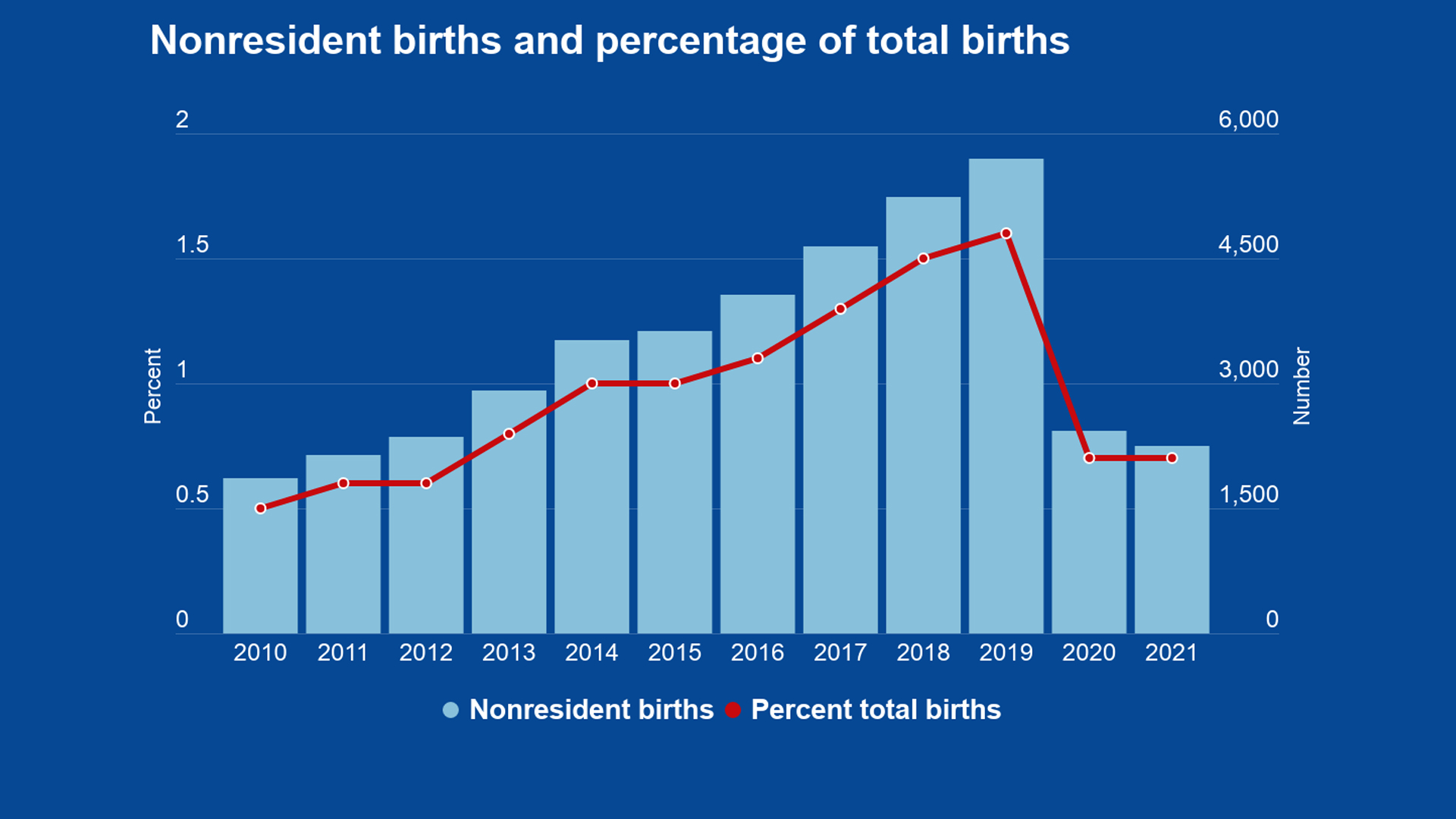
- Global Affairs
- Social Policy
Is birth tourism about to return now that travel restrictions have been lifted?

COVID-19 continues to provide the perfect natural experiment to assess the extent of “birth tourism” – when women visit Canada for the purpose of giving birth here and thus obtaining Canadian citizenship for their child. Two years in, the data shows a decrease of almost eight per cent, compared to 2020-21 and almost 52 per cent compared to the pre-pandemic 2016-20 average, in the number of “non-resident self-pay” births in Canada.
As Figure 1 indicates, there was a steady increase of non-resident births prior to the pandemic. But after COVID-related travel restrictions were implemented in 2020, there was a sharp drop, with no recovery in 2021. This provides a very good indication of the extent of birth tourism in Canada. Now that the restrictions are loosening and travel is once again opening up, it’s time for the federal government to revisit its policy on non-resident births and Canadian citizenship.
The decline to 2,245 in 2021 from 2,433 in 2020 occurred in all provinces save Quebec, which remained relatively stable (Table 1). The decline was particularly notable in British Columbia, where most birth tourists pre-pandemic were from China – a country most affected by travel restrictions. The drop is in stark contrast to steady increases over the previous five-year period.
A similar decline in visitor visas and birth tourists has been noted in the United States.
The percentage of non-resident births in Canada fell from slightly less than two per cent of total births in 2019 to 0.7 per cent in 2020 and has remained at that level. Given increased immigration, the percentage of non-resident births also fell during the same period.
As noted in previous articles , the non-resident self-pay code that is the basis for the analysis is broader than that of women who arrive on visitor visas. It includes international students, about half of whom are covered by provincial health plans, and other temporary residents. Visitor visas recovered to only 57 per cent of pre-pandemic levels in 2021-22 while visas for temporary workers have more than recovered from pre-pandemic levels. Visitor visas for Chinese nationals, one of the major groups, have recovered to only 21 per cent of former levels compared to 57 per cent of previous levels for all visitor visas. Chinese government travel-related restrictions are likely a significant factor in the reduced number.
Table 2 provides a hospital-level view of the impact of COVID, contrasting pre- and post-pandemic years in terms of non-resident and total births for the 10 hospitals with the largest percentage of non-resident births. Non-resident births continued to decline in most hospitals. British Columbia’s Richmond Hospital – the epicentre of birth tourism with its supportive “cottage industry” of “birth hotels” – has been the hardest hit. There was a decrease of 95.6 per cent compared to pre-pandemic levels.
This suggests that my initial estimate from 2018 that about 50 per cent of non-resident births were due to birth tourism was conservative, and that the percentage of “tourism births” is about one per cent of all births (or about 0.4 per cent of current immigration levels).
Three federal immigration ministers later, the government has not have followed up on its 2018 commitment to “better understand the extent of this practice as well as its impacts” following the first release of the Canadian Institute for Health Information numbers and related media attention. The 2021-22 decline understandably reduces political interest and pressure in addressing the issue, particularly at a time of government and stakeholder support of increased immigration, as the proportion on “non-resident” self-pay is only about 0.5 per cent of permanent resident admissions, having fallen from 1.7 per cent pre-pandemic.
Given the current focus on increased immigration, it is highly unlikely that the government will take action. The numbers are very small compared to the planned level of 500,000 immigrants to Canada in 2025 and Immigration, Refugees and Citizenship Canada’s current policy and operational challenges. However, given that visitor visas have largely reverted to pre-pandemic levels in 2022, growth in birth tourism can be expected in future years.
The government should address the policy deficit in this area. There appears to be public support for some action. A 2019 Angus Reid survey indicated that the vast majority of Canadians would support removing birthright citizenship for children born to women on visitor visas.
The use of CIHI data to quantify the extent of birth tourism, albeit approximately, highlights the potential in greater linkages between immigration and health data. With respect to birth tourism, the ability to distinguish between non-resident births for visitors, international students and temporary workers would provide greater precision on the extent of the practice.
It would also allow for more informed analysis and understanding of the health outcomes of immigrants and would identify opportunities for improvement.
The policy and operational questions remain as to whether the extent of birth tourism warrants an amendment to the Citizenship Act, visa restrictions on women intending to give birth in Canada, or other administrative and regulatory measures to curtail the practice. Because visa restrictions would be difficult to administer, and because regional administrative and regulatory measures may well encourage hospital and jurisdiction “shopping,” the “cleanest” approach would be an amendment to the Citizenship Act that would make Canadian citizenship dependent on one parent being a citizen or permanent resident, comparable to the situation in Australia .
A note on methodology
The data is from the CIHI ’ s Discharge Abstract Database, more specifically the responsible for funding program (RRFP) “ non-resident self-pay ” category, as well as totals for hospital deliveries. The RRFP data include temporary residents on visitor visas, international students, foreign workers and visiting Canadian citizens, and permanent residents. While Quebec has a slightly different coding system, CIHI ensures its data is comparable.
Health coverage for international students varies by provinces, but most are covered by provincial health plans. This is not the case in Manitoba and Ontario , and for some students in Quebec whose country of origin does not have a social security agreement with Quebec. The pre-pandemic baseline is the five-year average 2016-20.
Mackenzie Health ’ s Woman and Child program moved from Mackenzie Richmond Hill Hospital to Cortellucci Vaughan Hospital when it opened to the community in June 2021 .

You are welcome to republish this Policy Options article online or in print periodicals, under a Creative Commons/No Derivatives licence.
Republish this article
by Andrew Griffith. Originally published on Policy Options December 9, 2022
This <a target="_blank" href="https://policyoptions.irpp.org/magazines/december-2022/birth-tourism-may-rise-again/">article</a> first appeared on <a target="_blank" href="https://policyoptions.irpp.org">Policy Options</a> and is republished here under a Creative Commons license.<img id="republication-tracker-tool-source" src="https://policyoptions.irpp.org/?republication-pixel=true&post=105278&ga4=G-GR919H3LRJ" style="width:1px;height:1px;">

This work is licensed under a Creative Commons Attribution-NoDerivatives 4.0 International License .
Related stories
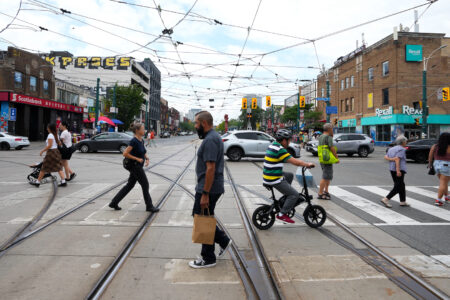
Questions persist as Ottawa prepares Citizenship Act amendments

An improved civic education will help sustain our democracy

B.C. bill on international credential recognition is a good start but needs improvement

SCHEDULE YOUR CONSULTATION! +1 (786) 474-1278
- Practice Areas
Having a baby in the United States as a tourist
- Having a baby in the…
Many couples enter the United States with the intention that their baby be born on American soil and thus be able to obtain immigration benefits.
If this is your family’s idea… keep reading to find out the positives and negatives of that strategy.

Traveling with a Tourist Visa while pregnant
Those who enter with a tourist visa B1 / B2, laser visa or without a visa (under the Visa Waiver Program) should take into account the pros and cons of their child being born in the United States.
The government has called this plan “baby tourism” that parents often want to carry out.
Starting in January 2020, immigration officers can deny tourist visas to pregnant women suspected of entering the United States with the sole purpose of giving birth in this country.
During the appointment, women must demonstrate different types of tests or evidence of the reasons why they want to travel.
Every baby born in the United States is automatically an American citizen , except for the children of diplomats who are in the United States exercising that function. In this type of specific exception, children acquire the nationality of their parents.
Once the children are born , the birth certificate is processed and with this document, they can obtain an American passport . Children born on American soil will continue to be American citizens for life , unless they carry out some action that as a punishment results in the loss of their nationality, regardless of whether, soon after being born, they emigrate to another country.
When the child is born in the United States, parents often think that children can petition for them at any time, but this is not the case. American citizens can petition for their parents only after they turn 21 years of age.
I invite you to read our article about how to extend your tourist visa if you have not read it! Here
It is not easy for a tourist to obtain health insurance in the United States or purchase insurance that covers all medical expenses. Therefore, parents must bear some of the medical expenses that the mother and baby may need.
What happens to medical expenses in the United States?
So that you can have an idea about the medical expenses that you may have, we leave you the data obtained from the “ International Federation of Health Plan ” where they highlight that a natural delivery (without complications), can cost around $ 11,000 dollars . While for a cesarean section , the approximate cost is $ 52,000 . Costs can vary depending on which state in the United States you give birth into, if multiple births exist, premature babies, or complications.
In the event that the parents do not have the money to pay the medical expenses, a social worker is present to have Medicaid cover those expenses. Medicaid is government insurance that covers the medical expenses of low-income American citizens and certain foreigners.
What then are the consequences of not paying medical expenses?
Without prior notice, both parent’s visas could get canceled or revoked .
Sometimes, it happens that parents go to the United States embassy in their country to renew the visa and by doing this they are automatically denied . Parents who enter with a laser visa or without a visa may also lose this benefit.
I hope you liked this information and it has been of value! We invite you to visit our page at Vargas Law Group

Andrew Henderson
Founder of Nomad Capitalist and the world’s most sought-after expert on global citizenship.
ABOUT THE COMPANY
What we’re all about
MEET OUR TEAM
Meet our 80+ global team
We’re here to serve you
Your questions answered
TESTIMONIALS
Read our testimonials
Get free email updates

ACTION PLAN
Our flagship service for entrepreneurs and investors
ACTION PLAN ELITE
Create your Action Plan directly with the Mr. Henderson himself
CITIZENSHIP BY DESCENT
Claim a second passport based on familial connections
ALL SERVICES
Click here to see all our products and services
GOING OFFSHORE
Offshore Banking
Offshore Company
Offshore Trust
Offshore Gold Storage
Offshore For Americans
SECOND CITIZENSHIP
Second Passport
Citizenship By Investment
Citizenship By Ancestry
Dual Citizenship Benefits
EU Citizenship
SECOND RESIDENCE
Second Residence
Golden Visas
Residence By Investment
EU Residence
Tax Residence
FINANCE & INVESTMENTS
Tax Reduction
International Investment
Cryptocurrency
Foreign Real Estate
Asset Protection
NOMAD LIFESTYLE
Flag Theory
Lifestyle Design
Plan B Strategy
Hiring Overseas
Living In Eastern Europe
PASSPORT INDEX
Discover the world’s best passports to have in an ever-changing world
CITIZENSHIP MAP
Explore the citizenship options using our interactive citizenship map
Explore the tax details for countries using our interactive tax map
ALL RESEARCH
Click here to see all of our research and interactive tools
THE WORLD’S #1 OFFSHORE EVENT
Kuala lumpur | september 25-28, 2024.
Learn from our R&D playbook and meet like-minded people at our annual event.
NOMAD CAPITALIST THE BOOK
Andrew Henderson wrote the #1 best-selling book that redefines life as a diversified, global citizen in the 21st century… and how you can join the movement.
Birth Tourism: 31 Countries Giving Birthright Citizenship

Last updated October 28, 2020
Dateline: Kuala Lumpur, Malaysia
If you have spent any time on our blog, you probably already know that there are a number of ways to get a second passport , depending on how badly you want one.
We recently discussed 13 citizenships you could get rather easily by using one of the oldest tricks in the book: marrying a foreigner .
However, obtaining second citizenship for your children and future generations is just as important – if not more so.
For years, surveys such as The Best Places to Be Born , the Better Life Index , the Human Development Report , and many Quality o f Life Indices have chronicled where children are likely to have it best.
I recently discussed this in my article on tips for parents-to-be , suggesting that parents who apply our principles of international diversification practice something called “ birth tourism .”
If you live in the United States, you have probably heard the term “anchor baby” – when a non-citizen gives birth to a child in a country with birthright citizenship to gain residence and citizenship advantages – positioned in a bad light. However, there is nothing stopping you from using the same principle to give your kids a head start in other countries around the world.
Parents have a unique opportunity to choose the best country to give birth in. It’s an opportunity even western citizens should consider since even the “first world” United Kingdom failed to crack the top 20 places in which to give birth, falling behind the likes of Montenegro and Lithuania . The study concluded that children born in Britain suffer higher infant mortality rates than many emerging countries.
So, how can you take advantage of the quality of life in other countries to give your child a better future by securing them a second passport just by being born? In this article, we’ll tell you how and where you can take advantage of birthright citizenship to do just that, and maybe even earn a second passport for yourself in the process.
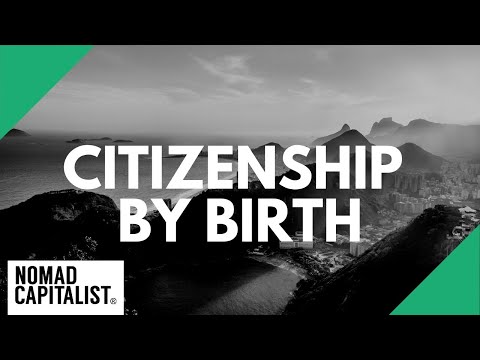
How Does Birth Tourism Work?
When it comes to determining a child’s citizenship at birth, countries usually apply one of two rights: jus soli (right of soil) or jus sanguinis (right of blood). Jus soli grants citizenship merely on the basis of being born “on the soil” of the country in question. Jus sanguinis determines the child’s citizenship based on the parents’ nationality.
Birth tourism is simple: give birth in a country that grants citizenship based on jus soli and provides benefits to all children born there. This will not only give your child a better qualify of life but also entitle them to a second passport immediately from birth. In many cases, parents of such children enjoy a faster naturalization timeline as well.
The process of “ jus soli ” is generally available to anyone who has a child within the territory of a country with birthright citizenship, even if they are a temporary resident or an illegal alien. The only people whose children do not qualify for instant citizenship are diplomats.
These countries offer what is called “ absolute jus soli ,” meaning that the biggest hurdle you’ll face in some countries is having to register your bundle of joy with the local authorities to secure their passport.
The United States and Canada are the only “first world countries” that offer unconditional citizenship to children born in the territory, although there are plenty of other excellent places that I would actually prefer to live in that offer this as well.
Here in Asia, Mainland Chinese parents often seek to give birth in Hong Kong to obtain the “right of abode” for their children. (Hong Kongers are Chinese citizens, but with special privileges to reside in Hong Kong.)
Of course, we know that the United States offers birthright citizenship for the same reasons that ancient Rome did: to increase the number of US tax-payers needed to pay off the country’s catastrophic debts.
Giving birth to a child in the United States is setting them up for a lifetime of taxes which they can’t even get out of without renouncing their citizenship. That means even opening a bank account for their college savings will require you to file paperwork with the US government.
What Countries Offer Birthright Citizenship?
For those who want to bestow their child with a second citizenship outside of the highly taxed western world, there are a number of places that offer “jus soli” or birthright of the soil.
Any child born within that country’s territory becomes a citizen at birth, and there are dozens of countries whose laws allow the practice. So, which countries automatically give a passport and citizenship to children born there, regardless of the nationality of the child’s parents?
Almost two decades ago, Ireland amended its constitution to end their practice as the last European country offering unconditional citizenship rights to children born to two foreign parents. Malta had amended theirs earlier, too. Other countries, such as Australia , have similarly tightened their laws.
But when you follow the birth tourism blueprint, you can forget about dual citizenship and give your child multiple citizenships .
Here is the full list of the best countries in which to give birth when seeking birth tourism options, excluding countries where a ban on the practice is currently underway.
- El Salvador
- St. Kitts and Nevis
- St. Vincent and the Grenadines
- Trinidad and Tobago
- United States
*For a child to become a Chilean citizen at birth, their parents must already have a temporary or permanent residence in Chile at the time of their birth.
**As of September 2020, Portugal is just a few formalities away from expanding its jus soli laws granting birthright citizenship to children born on Portuguese soil. Currently, children born in Portugal to foreign nationals can obtain citizenship at birth if at least one parent has been a resident for two years or more. The new law would reduce that timeline to one year.
This is an especially attractive change for Golden Visa investors in Portugal as they will now have the opportunity to bestow Portuguese citizenship on their children after just one year of residence.

The Best Birth Tourism Countries

Out of that list are a few gems…
Panama, Brazil, Mexico, and Argentina are particularly noted for their quality medical care , including for world-class facilities that make giving birth there not only easy but much cheaper than any country in the West.
Two of the countries — Dominica and St. Kitts and Nevis — sell economic citizenships for six-figure price tags and even charge for your children to receive a passport, as well. Other countries that used to offer citizenship by investment programs, such as Belize, are also attractive birth tourism options.
Similar to how US persons complain of illegal immigrants getting access to welfare benefits for their US citizen child, several countries on this list offer the ability to fast track your own naturalization as the parent of a local child.
In Brazil, the wait is only one year, prompting my friend Neil Strauss to suggest “knocking up a Brazilian girl” in his book Emergency . But in all seriousness, even foreigners on tourist visas can give birth on Brazilian soil, earning their child immediate Brazilian citizenship and a one-year timeline to their own naturalization. You can learn more about Brazil’s birthright citizenship laws here .
Most other countries will fast track the parents’ naturalization so that you will be able to get citizenship in two to seven years.
And surprisingly, some of these countries offer remarkably good passports . Holders of passports from Argentina, Costa Rica, Mexico , Panama , St. Kitts and Nevis, Uruguay , and Venezuela enjoy visa-free travel to all of Central and South America as well Europe’s borderless Schengen Area and almost every country in Europe.
Some even offer travel privileges to countries that westerners do not have visa-free access to, like Russia.
Guatemala passport holders enjoy all of these privileges save the right to travel to Mexico. Nicaragua citizens enjoy Schengen area access, but more limited options within the Americas. And even some of the lesser passports here allow for visa-free travel of some sort to the UK, Ireland, Malaysia, and Singapore.
For someone interested in raising their family in the world’s emerging markets, the Peruvian passport allows for more visa-free travel to Southeast Asia and South American countries than most “first world” passports.
Outside of Canada and Chile , none of these citizenships will allow your child to visit the United States visa-free. But if you’re reading this, you might actually view that as an added benefit rather than a detriment.
Keeping your child in a growing, more laissez-faire environment is the best way to make the most of his or her birth tourism citizenship.
Be careful that you have the most up-to-date information before giving birth overseas, as a number of countries have ended their policy of giving citizenship based on birthplace; these include Australia, most recently, as well as New Zealand, Ireland, France, Malta, the Dominican Republic (which led to tens of thousands of deportations ), and India.
Of course, only you can determine how far you want to take the second citizenship and birth tourism game in an effort to bestow as many nationalities on your children as possible.
And if you happen to be pregnant now, you could always book your hospital stay and join us for one of our upcoming events on the beach.
GET ACTIONABLE TIPS FOR REDUCING TAXES AND BUILDING FREEDOM OVERSEAS
Sign up for our Weekly Rundown packed with hand-picked insights on global citizenship, offshore tax planning, and new places to diversify.
Are you a US citizen?
YOU MAY ALSO LIKE

What is Panama’s Qualified Investor ‘Red Carpet’ Visa?
If you imagine Panama is full of dirt roads, rural squalor and economic disadvantage, think again....

How to Get Serbian Citizenship by Exception
What do Johnny Depp, Steven Seagal, and Ralph Fiennes have in common? Well, apart from the...

How Does Italy’s ‘La Dolce Visa’, Work?
How do you even begin to explain the charm of Italy for expats? Italy's attractions include...
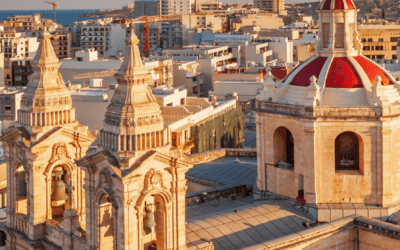
Malta’s Permanent Residence Program: The Ultimate Guide
Arriving in Malta at the break of dawn, the first glimpse of the island emerges from the quiet...
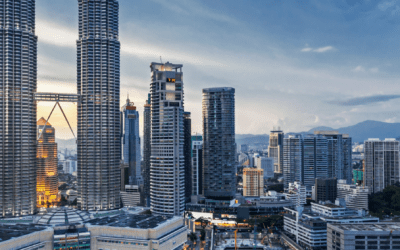
How to Pay Zero or Low Taxes in Malaysia (Territorial Tax)
Malaysia is beautiful, but don't just take our word for it. It's been officially recognised as the...

How to Pay Zero or Low Taxes in Costa Rica (Territorial Tax)
Costa Rica offers a stable political climate, a strong expat community, and good infrastructure....
Get the Right Passport for You
We’ve helped our clients obtain 28 different country’s citizenships, from often-overlooked ancestry programs, to fast-tracked investment options, and even exclusive programs for HNWIs. Don’t limit yourself; let Nomad Capitalist’s unbiased approach help you find the best option.
What do you want to accomplish?
Let us know your goal and we will tell you how we can help you based on your details.
REDUCE TAXES OFFSHORE
CREATE A GLOBAL PLAN B
DIVERSIFY AND PROTECT WEALTH

UNITED STATES

UNITED KINGDOM

EU COUNTRIES

Tax Amount ($US Dollars)
POLITICAL INSTABILITY
ECONOMIC INSTABILITY
MISSED OPPORTUNITIES
TRAVEL RESTRICTIONS
HIGH TAX LIABILITIES
RISK MANAGEMENT
MARKET PROTECTION
WEALTH PRESERVATION
OPPORTUNITY CAPITALIZATION
ESTATE PLANNING
Email Address
We handle your data according to our Privacy Policy . By entering your email address you grant us permission to send you the report and follow up emails later.
'All about the money': How women travelling to Canada to give birth could strain the health-care system
Birth tourism leads to complaints of compromised care at b.c. hospital.

Social Sharing
Women travelling to Canada to give birth to babies who will automatically become Canadian citizens are prompting concerns about the strain they may be putting on the health-care system, The Fifth Estate has found.
Canada is one of fewer than three dozen countries that follow the practice of citizenship based on birthplace, regardless of parents' nationality or status.
At one British Columbia hospital with a high concentration of such deliveries, complaints have arisen that the influx of these non-resident patients — also known as birth tourists — has led to compromised care for local mothers-to-be and struggles for nursing staff.
Some of these patients fail to pay hospital and doctors bills, leaving taxpayers and individual care providers on the hook.
"Most of them, they get the Canadian passport, and then they leave the country," said Dr. Mudaffer Al-Mudaffer, a B.C. pediatrician and neonatologist who sees babies of non-residents when they need critical care. "It affects the integrity of the fairness of the health system."
No statistics are available regarding how many people are travelling to Canada specifically to ensure their child is born here and will have a Canadian passport.
But figures from the Canadian Institute for Health Information and several Quebec hospitals indicate there were about 5,000 non-resident births across the country in 2018, an increase of nearly 15 per cent over the previous year.

In the fall of 2019, Cathy Shi arrived in Richmond, B.C., from Shandong, on China's east coast, to give birth to her third child. She said through a translator that she wanted her unborn child to have more opportunities.
"My concern is about their education, such as going to university. If the kid wants to live in Canada, it would be convenient for them if they're born here."
Handful of hospitals
At this point, the practice of birth tourism appears to be concentrated in a handful of hospitals in Quebec, Ontario and British Columbia.
At the Richmond Hospital, south of Vancouver, non-residents make up nearly a quarter of all births, according to records obtained from Vancouver Coastal Health, the health authority which runs the hospital. In many ways, that hospital can be seen as a test case for how this issue could play out elsewhere as numbers continue to climb.
The health authority declined a request for an interview with The Fifth Estate and issued a warning directing its staff not to speak to the media.
Despite that, four current and two retired nurses shared their concerns, requesting that their identities be protected.
- Watch "Passport babies" on The Fifth Estate on CBC-TV Sunday at 9 p.m.
Since 2013/14, the number of non-resident births has tripled at the hospital. The patients — many from China — pay privately for their care, often in cash, may not speak English and are unfamiliar with the Canadian health-care system. The nurses who spoke to The Fifth Estate say the influx has led to increased workloads and has compromised care.

"There are times when ... the people living here don't get the service that they need," one nurse said.
When the unit was very busy, one nurse said services like prenatal tests to check the baby's health, labour inductions and other tests to check fetal and maternal risk factors would be delayed or cancelled.
"We would often have to decide whose need was greatest and abandon the rest for the next day where we would face the same situation again," she said.
"Our normal scheduled or add-on C-sections lie here all day and then they take the IV out, we send them home and say come back tomorrow. A private pay never goes home — she gets her C-section that day," said another nurse.
"She will be fit in somewhere because nobody wants to lose that $5,000. But our normal people are lying there all day, no food or drink, waiting and nobody's interested in moving them."
Some hospitals, like Sunnybrook Health Sciences Centre in Toronto, have taken steps to limit the number of non-resident births in order to prioritize residents of their own communities. That hospital says it won't treat non-residents patients without Ontario Health Insurance Plan coverage.
- Ottawa probes birth tourism as new data shows higher non-resident birth rates
'It's fraudulent': Former immigration official says action needed on 'passport babies'
When asked in an email why the Richmond Hospital doesn't have a similar policy, Carrie Stefanson, a public affairs representative with Vancouver Coastal Health, said: "VCH cannot speak for other hospitals or health authorities. VCH will never deny urgent and emergent care based on ability to pay or where a patient is from."
The hospital requests deposits for privately paid births: $10,000 for a vaginal birth and $16,000 for a caesarean. More than $18 million has been invoiced for non-resident births since 2017, according to data released through freedom of information by Vancouver Coastal Health.
Nursing staff say they have not seen this money go into easing their workloads.
"The amount of money that's coming into Richmond from the private pay, it doesn't make our staffing better," said one nurse.
Their union says that is a problem.

"I certainly think adding additional patients into a health-care system that isn't staffed appropriately, isn't funded appropriately, is causing strain," said Christine Sorensen, president of the BC Nurses' Union.
She said the union has regularly heard complaints from nurses at Richmond Hospital but they have not filed a formal complaint with the hospital.
The health authority declined to answer a question about how it has responded to complaints from nursing staff.
Financial incentives within the medical system
Two doctors at the Richmond Hospital have delivered 1,300 of the 2,206 babies born to non-residents there since 2014, according to documents released through freedom of information.
While the health authority will not disclose their names, insiders and birth tourism company representatives say Dr. Xin-Yong Wang and Dr. Brenda Tan, two Mandarin-speaking family doctors, see the majority of these patients for prenatal care and delivery.
Both appear on multiple websites of companies advertising services such as assistance with immigration, travel and housing to women looking to come to Canada to give birth.
Wang said the companies do not have permission to use his name.
Tan did not respond to interview requests and a list of questions sent to her.

Wang and Tan billed the province $272,198.50 and $428,456.17 respectively in the 2018/2019 fiscal year, according to data publicly available through the province. Those billings do not include earnings from non-resident patients because they pay privately.
There are no limits on what physicians can charge outside the public system in British Columbia, but information from birth tourism company websites suggests that these doctors earn at least $100 per prenatal visit and more than $2,500 for a delivery, several times more than could be billed through the public system for the same services.
In an interview, Wang declined to respond to questions about how much he was earning from birth tourism but said he was not motivated financially to take on these patients.
"It's like a dessert — occasional patients like this is fine, and it's pretty financially rewarding … they are a small percentage of our overall income."
Nurses who spoke to The Fifth Estate said the financial incentives within the health-care system are a problem.
"It is all about the money. If there was no financial income for the hospital or physicians, the private pay would have been out of the door a long time ago," said one nurse.
Unpaid bills
While these births are bringing in money, bills owed to both health authorities and individual doctors are not always paid.
According to documents released by Vancouver Coastal Health, more than $2 million is outstanding as a result of non-resident births since 2017 at the Richmond Hospital alone. This does not include any debt that has been written off.
Births at the Richmond Hospital represent 11 per cent of overall non-resident births outside Quebec, according to 2018 data from the Canadian Institute for Health Information.
No national financial data exists on how much revenue is outstanding as a result of non-resident hospital bills across the country.
But some say the health-care system and Canadian taxpayers are losing out.
Al-Mudaffer said having an uninsured baby in neonatal intensive care can cost $10,000 a day just for the hospital bed, not including doctors' fees.
Watch Dr. Al-Mudaffer express concerns about birth tourism:

Dr. Mudaffer Al-Mudaffer
He said he's seen large bills for families with babies requiring multiple nights and even weeks in the NICU.
"You can easily acquire a bill of $100,000 to pay the health authority, and that's why they can't pay it, you know? And they leave the country without paying," said Al-Mudaffer.
He said he has seen hundreds of thousands of dollars in bills go unpaid at the Royal Columbian Hospital where he works, but Fraser Health, which runs that hospital, said it could not confirm this amount.
The Fifth Estate requested provincial numbers on unpaid bills from the British Columbia government but was told these numbers were not tracked provincially.
"Obviously if any bill is unpaid, I'm concerned about that because that's money that we could and should be spending on something else or saving the health-care system so of course we're concerned about it," said B.C. Health Minister Adrian Dix.
Even with little formal research to examine the practical implications of a growing number of non-resident births on the Canadian health-care system, Dix said "we are handling that situation.
"It's two per cent … of total births in British Columbia, so it's an issue but there are other issues."

But it's not only hospital fees going unpaid. Al-Mudaffer said when he sees birth tourists, he only gets paid three out of 10 times.
He is not alone. Dr. Kathleen Ross, president of Doctors of B.C., has personally been affected by unpaid bills and has called for a national conversation on the issue.
"Our federal government needs to find a way to disincentive people coming to the country to have access to citizenship and to our health-care support," she said.
Federal research planned
Marco Mendicino, the newly appointed minister of immigration, refugees and citizenship, declined an interview with The Fifth Estate .
But the department wrote that while "statistics indicate that birth tourism is not widespread, the Government of Canada recognizes the need to better understand this practice."
It said it has started work with the Canadian Institute for Health Information and Statistics Canada to integrate health and immigration data that would allow for a better understanding of the practice of birth tourism by looking at visitor visas and births.
Immigration, Refugees and Citizenship Canada anticipates results from this research will be available in the spring.
Cathy Shi said she hasn't thought much about criticism of birth tourism and isn't receiving any government benefits here.
"We may come here often for travelling around, living or even investing. People are not just looking for status by having a baby here. They will have established a connection to Canada and later on some may apply to immigrate."
For more information, on this story please contact Annie Burns-Pieper [email protected]
ABOUT THE AUTHOR

Annie Burns-Pieper is a freelance investigative reporter and producer. She has a particular interest in themes of gender equality, public safety and health.
- @Aburnspieper

An official website of the United States government
Here’s how you know
Official websites use .gov A .gov website belongs to an official government organization in the United States.
Secure .gov websites use HTTPS A lock ( Lock A locked padlock ) or https:// means you’ve safely connected to the .gov website. Share sensitive information only on official, secure websites.

U.S. Department of Commerce
- Fact Sheets
Was this page helpful?
Fact sheet: 2022 national travel and tourism strategy, office of public affairs.
The 2022 National Travel and Tourism Strategy was released on June 6, 2022, by U.S. Secretary of Commerce Gina M. Raimondo on behalf of the Tourism Policy Council (TPC). The new strategy focuses the full efforts of the federal government to promote the United States as a premier destination grounded in the breadth and diversity of our communities, and to foster a sector that drives economic growth, creates good jobs, and bolsters conservation and sustainability. Drawing on engagement and capabilities from across the federal government, the strategy aims to support broad-based economic growth in travel and tourism across the United States, its territories, and the District of Columbia.
The federal government will work to implement the strategy under the leadership of the TPC and in partnership with the private sector, aiming toward an ambitious five-year goal of increasing American jobs by attracting and welcoming 90 million international visitors, who we estimate will spend $279 billion, annually by 2027.
The new National Travel and Tourism Strategy supports growth and competitiveness for an industry that, prior to the COVID-19 pandemic, generated $1.9 trillion in economic output and supported 9.5 million American jobs. Also, in 2019, nearly 80 million international travelers visited the United States and contributed nearly $240 billion to the U.S. economy, making the United States the global leader in revenue from international travel and tourism. As the top services export for the United States that year, travel and tourism generated a $53.4 billion trade surplus and supported 1 million jobs in the United States.
The strategy follows a four-point approach:
- Promoting the United States as a Travel Destination Goal : Leverage existing programs and assets to promote the United States to international visitors and broaden marketing efforts to encourage visitation to underserved communities.
- Facilitating Travel to and Within the United States Goal : Reduce barriers to trade in travel services and make it safer and more efficient for visitors to enter and travel within the United States.
- Ensuring Diverse, Inclusive, and Accessible Tourism Experiences Goal : Extend the benefits of travel and tourism by supporting the development of diverse tourism products, focusing on under-served communities and populations. Address the financial and workplace needs of travel and tourism businesses, supporting destination communities as they grow their tourism economies. Deliver world-class experiences and customer service at federal lands and waters that showcase the nation’s assets while protecting them for future generations.
- Fostering Resilient and Sustainable Travel and Tourism Goal : Reduce travel and tourism’s contributions to climate change and build a travel and tourism sector that is resilient to natural disasters, public health threats, and the impacts of climate change. Build a sustainable sector that integrates protecting natural resources, supporting the tourism economy, and ensuring equitable development.
Travel and Tourism Fast Facts
- The travel and tourism industry supported 9.5 million American jobs through $1.9 trillion of economic activity in 2019. In fact, 1 in every 20 jobs in the United States was either directly or indirectly supported by travel and tourism. These jobs can be found in industries like lodging, food services, arts, entertainment, recreation, transportation, and education.
- Travel and tourism was the top services export for the United States in 2019, generating a $53.4 billion trade surplus.
- The travel and tourism industry was one of the U.S. business sectors hardest hit by the COVID-19 pandemic and subsequent health and travel restrictions, with travel exports decreasing nearly 65% from 2019 to 2020.
- The decline in travel and tourism contributed heavily to unemployment; leisure and hospitality lost 8.2 million jobs between February and April 2020 alone, accounting for 37% of the decline in overall nonfarm employment during that time.
- By 2021, the rollout of vaccines and lifting of international and domestic restrictions allowed travel and tourism to begin its recovery. International arrivals to the United States grew to 22.1 million in 2021, up from 19.2 million in 2020. Spending by international visitors also grew, reaching $81.0 billion, or 34 percent of 2019’s total.
More about the Tourism Policy Council and the 2022 National Travel and Tourism Strategy
Created by Congress and chaired by Secretary Raimondo, the Tourism Policy Council (TPC) is the interagency council charged with coordinating national policies and programs relating to travel and tourism. At the direction of Secretary Raimondo, the TPC created a new five-year strategy to focus U.S. government efforts in support of the travel and tourism sector which has been deeply and disproportionately affected by the COVID-19 pandemic.
Read the full strategy here
S. 17 (117 th ): Ban Birth Tourism Act
React to this bill with an emoji, save your opinion on this bill on a six-point scale from strongly oppose to strongly support.
(Shared on panel .)
Widget for your website
Get a bill status widget »
Follow GovTrack on social media for more updates:
Visit us on Mastodon
- Study Guide
Add a note about this bill. Your note is for you and will not be shared with anyone.
Because you are a member of panel , your positions on legislation and notes below will be shared with the panel administrators. ( More Info )
A bill to amend the Immigration and Nationality Act to provide for inadmissibility of certain aliens seeking citizenship for children by giving birth in the United States, and for other purposes.
The bill’s titles are written by its sponsor.
Sponsor and status

Marsha Blackburn
Sponsor. Senior Senator for Tennessee. Republican.
This bill was introduced on January 22, 2021, in a previous session of Congress, but it did not receive a vote.
Although this bill was not enacted, its provisions could have become law by being included in another bill. It is common for legislative text to be introduced concurrently in multiple bills (called companion bills), re-introduced in subsequent sessions of Congress in new bills, or added to larger bills (sometimes called omnibus bills).
Position statements
What legislators are saying.
“ rep Lieu announces virtual guest for president bidens state of the union address ” — Rep. Ted Lieu [D-CA36] on Mar 1, 2022
“ Klobuchar Introduces Bipartisan Legislation to Increase Access to Health Care in Medically Underserved Areas ” — Sen. Amy Klobuchar [D-MN] on May 27, 2021
“ Congressman Kweisi Mfumes Statement on the Passage of the Build Back Better Act ” — Rep. Kweisi Mfume [D-MD7] on Nov 19, 2021
More statements at ProPublica Represent...
S. 17 (117th) was a bill in the United States Congress.
A bill must be passed by both the House and Senate in identical form and then be signed by the President to become law.
Bills numbers restart every two years. That means there are other bills with the number S. 17. This is the one from the 117 th Congress.
This bill was introduced in the 117 th Congress, which met from Jan 3, 2021 to Jan 3, 2023. Legislation not passed by the end of a Congress is cleared from the books.
How to cite this information.
We recommend the following MLA -formatted citation when using the information you see here in academic work:
GovTrack.us. (2024). S. 17 — 117th Congress: Ban Birth Tourism Act. Retrieved from https://www.govtrack.us/congress/bills/117/s17
“S. 17 — 117th Congress: Ban Birth Tourism Act.” www.GovTrack.us. 2021. June 4, 2024 <https://www.govtrack.us/congress/bills/117/s17>
Ban Birth Tourism Act, S. 17, 117th Cong. (2021).
{{cite web |url=https://www.govtrack.us/congress/bills/117/s17 |title=S. 17 (117th) |accessdate=June 4, 2024 |author=117th Congress (2021) |date=January 22, 2021 |work=Legislation |publisher=GovTrack.us |quote=Ban Birth Tourism Act }}
- show another citation format:
- Wikipedia Template
Where is this information from?
GovTrack automatically collects legislative information from a variety of governmental and non-governmental sources. This page is sourced primarily from Congress.gov , the official portal of the United States Congress. Congress.gov is generally updated one day after events occur, and so legislative activity shown here may be one day behind. Data via the congress project .
[error message]
Why does the US fertility rate keep dropping?
Women are less eager to have children
- Newsletter sign up Newsletter
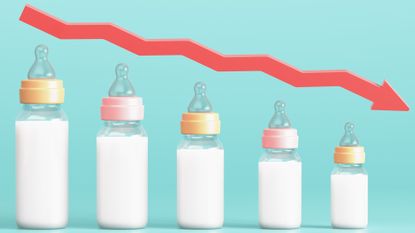
The U.S. fertility rate dropped to a record low in 2023. Birth rates have been declining for the last few decades, and Americans are currently not having enough children to replace the country's population. Much of the birth-rate decline can be attributed to ongoing social and economic issues leading women to have fewer children later in life.
How did US fertility rates change in 2023?
Provisional data for 2023 by the Centers for Disease Control and Prevention (CDC) found that the total fertility rate in the U.S. dropped to its lowest since birth rate data began being tracked in 1979, decreasing by 2% in 2023 compared to 2022. This also marked the end of the pandemic baby boom. "A confluence of factors are at play. American women are having fewer children, later in life," said The Wall Street Journal . "Women are establishing fulfilling careers and have more access to contraception."
Teen birth rates reached a record low, while birth rates among older women decreased at smaller rates than those of younger women. The highest birth-rate levels were seen among women between 30 and 34 years old. "One factor, of course, is the option to wait. We had a pandemic, or there's an economic downturn, let's say — women in their 20s can postpone having a birth until things improve. … For older women, the option of waiting is not as viable." Women of color saw more of a decline than their white counterparts. The fertility rate declined 5% for Black women and American Indian and Alaska Native women, and 3% for Asian women.
Subscribe to The Week
Escape your echo chamber. Get the facts behind the news, plus analysis from multiple perspectives.

Sign up for The Week's Free Newsletters
From our morning news briefing to a weekly Good News Newsletter, get the best of The Week delivered directly to your inbox.
"People are making rather reasoned decisions about whether or not to have a child," Karen Benjamin Guzzo, the director of the Carolina Population Center at the University of North Carolina at Chapel Hill, said to the Journal. "More often than not, I think what they're deciding is 'Yes, I'd like to have children, but not yet.'" On a larger scale, the U.S. population is expected to begin declining in 2080, according to the Census Bureau . The repercussions are still unknown but could affect programs like Social Security. This shift "has the ability to have a significant impact on the way we live for a long time to come," Phillip Levine, an economics professor at Wellesley College, said to the Journal.
Why are US fertility rates dropping?
The dropping fertility rate is a reflection of current social and economic issues. "For the first time in our nation's history, a 30-year-old man or woman isn't doing as well as his or her parents were at 30. That is the social compact breaking down," Scott Galloway, a professor at New York University's Stern School of Business, said in an interview with Fortune . In addition, "Millennials and Gen Zers face sky-high mortgage rates, soaring home prices and inflation, and it's slowing some traditional, or otherwise historic, milestones like having a child," Fortune said.
Women across the country are also experiencing a "growing concern over access to reproductive healthcare and politicized debate over abortion access , as well as concerns over the economy, a lack of rights for working parents and growing fears over the future of the planet," said Forbes . For these reasons, many are opting to remain childless. "While countries including France and China have taken measures to try to encourage couples to have children, U.S. birth rates have been stifled by forces like lack of paid family leave and skyrocketing health costs," Time said.
The U.S. is not the only country facing population issues. A study published in The Lancet found that 198 out of 204 countries are likely to see a population decline by the year 2100. "The implications are immense," Natalia V Bhattacharjee, co-lead author of the study, said to Al Jazeera . "These future trends in fertility rates and live births will completely reconfigure the global economy and the international balance of power and will necessitate reorganizing societies."
Sign up for Today's Best Articles in your inbox
A free daily email with the biggest news stories of the day – and the best features from TheWeek.com
Devika Rao has worked as a staff writer at The Week since 2022, covering science, the environment, climate and business. She previously worked as a policy associate for a nonprofit organization advocating for environmental action from a business perspective.

Cartoons Sunday's cartoons - regular guys, tech regulation, and more
By The Week US Published 2 June 24

Cartoons Artists take on greedflation, price gouging, and more

The Week Recommends This tasty recipe offers a fun twist on tradition
By The Week UK Published 2 June 24

The explainer Getting to the Red Planet requires planning and a whole lot of knowledge
By Devika Rao, The Week US Published 28 May 24

The Explainer Meteor showers, eclipses and more are coming to the skies
By Devika Rao, The Week US Published 23 May 24

The Explainer The creation of 'coordinated lunar time' is part of Nasa's mission to establish a long-term presence on Earth's only natural satellite
By Richard Windsor, The Week UK Published 4 April 24

under the radar Faced with losing their jobs, they are making a life-altering decision
By Theara Coleman, The Week US Published 27 March 24

The explainer Yes, even you. The practice is being increasingly accepted by researchers as a way to gather data.
By Devika Rao, The Week US Published 27 March 24

The Explainer A new sex gene could be on the evolution pipeline
By Devika Rao, The Week US Published 14 March 24

The Explainer One giant leap for mankind
By Devika Rao, The Week US Published 6 March 24

The Explainer Why driverless vehicles are still a very rare sight on the world’s roads today
By The Week UK Published 25 February 24
- Contact Future's experts
- Terms and Conditions
- Privacy Policy
- Cookie Policy
- Advertise With Us
The Week is part of Future plc, an international media group and leading digital publisher. Visit our corporate site . © Future US, Inc. Full 7th Floor, 130 West 42nd Street, New York, NY 10036.
Births decline in most states, continuing a long-term trend
Fast-growing Texas and Florida had the biggest increases in the number of births last year, while a dozen other states — half of them in the South — continued to rebound from pandemic lows.
In the United States as a whole, however, the number of births has plateaued after a modest increase following the worst of the pandemic, according to preliminary data from the federal Centers for Disease Control and Prevention.
Births increased in only 15 states from 2021 to 2022, compared with growth in 43 states between 2020 and 2021. More detailed statistics, which could shift slightly, are due for release June 1.
More: Cities shrink, but immigrants help stem population losses
Overall, the new data shows the continuation of a long-term trend toward fewer births in the United States, said Phillip Levine, an economics professor at Wellesley College who studies birth trends. Births were down more than 650,000 or 15% over the past 15 years.
“We’re back where we started before COVID hit,” Levine said. “Births are still declining, albeit perhaps at a slower pace. There certainly is no reason to stop sounding the sirens on the long-term decline in births in the United States.”
Without an increase in immigration, that trend could mean an older population, a smaller workforce and diminished economic productivity . That’s true even in Texas, where second-generation immigrants and women under 30 in general are increasingly postponing parenthood .
Illinois, Pennsylvania and Michigan, states where the overall population is declining, experienced the largest decreases in births.
In Texas and Florida, the number of births was up 4% in 2022 compared with 2021. In terms of overall population, they are the fastest-growing states as of mid-2022, according to the latest U.S. Census Bureau estimates .
In Texas, births increased by almost 16,000, compared with an increase of 5,400 between 2020 and 2021. In Florida the increase was about 8,200 compared with 6,600 the previous year. Other states with increases between 2021 and 2022 were Georgia (about 1,900), North Carolina (1,200), New Jersey (795), Arizona (526), Virginia (361), Tennessee (359), Delaware (353), South Carolina (302), Maryland (272) and Kentucky (262). Kansas, Idaho and Alaska had increases of fewer than 100 each.
Nationally, there were 700 more births in 2022 than there were in 2021. Between 2020 and 2021, the number of births increased by 51,000.
Florida’s increase in births is partly a reflection of more people moving to the state, but also higher birth rates after a dip during the depths of the pandemic, said Stefan Rayer, population program director at the University of Florida’s Bureau of Economic and Business Research. Even in Florida, however, the long-term trend is bending downward, with birth rates for Black, white and Hispanic women well below the peaks in the mid-2000s.
Arizona’s increase of about 500 births, about half the number of the previous year’s increase, may already be turning into a small decrease in early 2023, State Demographer Jim Chang said.
Illinois had the biggest drop in births, about 4,400, almost four times the previous year’s drop of 1,100. Pennsylvania and Michigan (both about -2,800) and New York (-2,300) saw births decline in 2022 after increases between 2020 and 2021.
It was a different story between 2020 and 2021, when New England states saw the largest increases. New Hampshire, Connecticut and Vermont had the largest percentage increases, according to final 2021 birth data released earlier this year.
Only North Dakota has bucked the overall trend of fewer annual births since 2007. Despite a drop in 2022, the state still had about 800 more births in 2022 than it did in 2007. As North Dakota’s fracking industry in the Bakken Formation has grown in that time, it has attracted more young people of childbearing age, said Kevin Iverson, a demographer in the state Department of Commerce.
More: Low fertility rates, high housing prices mean fewer children in most states
In Texas, some lawmakers are worried about too many babies being born without the health and social services infrastructure to support them. Prenatal care is already difficult to find, especially for poor women in rural areas of Texas, and the state recently enacted a strict abortion ban.
Texas state Rep. Claudia Ordaz Perez, a Democrat representing part of El Paso, has called Texas “one of the most dangerous states in the nation to have a baby,” citing high maternal mortality and low rates of health insurance.
Like other Western states, Texas has seen a recent decline in birth rates because of a downturn in immigration from Mexico and fewer births to young women in general, according to a 2021 report by the Federal Reserve Bank of Dallas.
Some attribute declining birth rates to more women recognizing that they can find success and fulfillment working outside the home — whether or not they decide to become mothers.
“There might be unique explanations for each little squiggle in fertility trends, but the world is going to have to adjust to reality of permanent below-replacement fertility,” said Charles Hirschman, a professor emeritus at the University of Washington who studies fertility trends He cited recent work by Frances Goldscheider, a sociologist at the University of Pennsylvania.
“We have successfully had the first gender revolution with women almost reaching parity in traditional male roles, but there has been little progress in bringing men into participating equality in household and child-rearing roles,” Hirschman said.
Stateline is part of States Newsroom, a network of news bureaus supported by grants and a coalition of donors as a 501c(3) public charity. Stateline maintains editorial independence. Contact Editor Scott Greenberger for questions: [email protected] . Follow Stateline on Facebook and Twitter .
Numbers, Facts and Trends Shaping Your World
Read our research on:
Full Topic List
Regions & Countries
- Publications
- Our Methods
- Short Reads
- Tools & Resources
Read Our Research On:
- The State of the American Middle Class
Who is in it and key trends from 1970 to 2023
Table of contents.
- Acknowledgments
This report examines key changes in the economic status of the American middle class from 1970 to 2023 and its demographic attributes in 2022. The historical analysis is based on U.S. Census Bureau data from the Annual Social and Economic Supplements (ASEC) of the Current Population Survey (CPS). The demographic analysis is based on data from the American Community Survey (ACS). The data is sourced from IPUMS CPS and IPUMS USA , respectively.
The CPS, a survey of about 60,000 households, is the U.S. government’s official source for monthly estimates of unemployment . The CPS ASEC, conducted in March each year, is the official source of U.S. government estimates of income and poverty . Our analysis of CPS data starts with the 1971 CPS ASEC, which records the incomes of households in 1970. It is also the first year for which data on race and ethnicity is available. The latest available CPS ASEC file is for 2023, which reports on household incomes in 2022.
The public-use version of the ACS is a 1% sample of the U.S. population, or more than 3 million people. This allows for a detailed study of the demographic characteristics of the middle class, including its status in U.S. metropolitan areas. But ACS data is available only from 2005 onward and is less suitable for long-term historical analyses. The latest available ACS data is for 2022.
Middle-income households are defined as those with an income that is two-thirds to double that of the U.S. median household income, after incomes have been adjusted for household size. Lower-income households have incomes less than two-thirds of the median, and upper-income households have incomes that are more than double the median. When using American Community Survey (ACS) data, incomes are also adjusted for cost of living in the areas in which households are located.
Estimates of household income are scaled to reflect a household size of three and expressed in 2023 dollars. In the Current Population Survey (CPS), household income refers to the calendar year prior to the survey year. Thus, the income data in the report refers to the 1970-2022 period, and the share of Americans in each income tier from the CPS refers to the 1971-2023 period.
The demographic attributes of Americans living in lower-, middle- or upper-income tiers are derived from ACS data. Except as noted, estimates pertain to the U.S. household population, excluding people living in group quarters.
The terms middle class and middle income are used interchangeably in this report.
White, Black, Asian, American Indian or Alaska Native, and Native Hawaiian or Pacific Islander include people who identified with a single major racial group and who are not Hispanic. Multiracial includes people who identified with more than one major racial group and are not Hispanic. Hispanics are of any race.
U.S. born refers to individuals who are U.S. citizens at birth, including people born in the 50 U.S. states, the District of Columbia, Puerto Rico or other U.S. territories, as well as those born elsewhere to at least one parent who is a U.S. citizen. The terms foreign born and immigrant are used interchangeably in this report. They refer to people who are not U.S. citizens at birth.
Occupations describe the broad kinds of work people do on their job. For example, health care occupations include doctors, nurses, pharmacists and others who are directly engaged in the provision of health care. Industries describe the broad type of products companies produce. Each industry encompasses a variety of occupations. For example, the health care and social assistance industry provides services that are produced by a combination of doctors, managers, technology and administrative staff, food preparation workers, and workers in other occupations.
The share of Americans who are in the middle class is smaller than it used to be. In 1971, 61% of Americans lived in middle-class households. By 2023, the share had fallen to 51%, according to a new Pew Research Center analysis of government data.
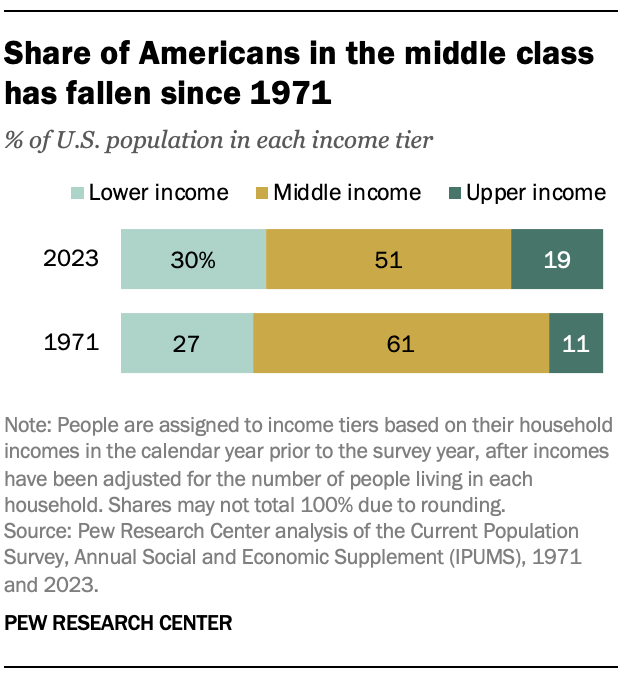
As a result, Americans are more apart than before financially. From 1971 to 2023, the share of Americans who live in lower-income households increased from 27% to 30%, and the share in upper-income households increased from 11% to 19%.
Notably, the increase in the share who are upper income was greater than the increase in the share who are lower income. In that sense, these changes are also a sign of economic progress overall.
But the middle class has fallen behind on two key counts. The growth in income for the middle class since 1970 has not kept pace with the growth in income for the upper-income tier. And the share of total U.S. household income held by the middle class has plunged.
Moreover, many groups still lag in their presence in the middle- and upper-income tiers. For instance, American Indians or Alaska Natives, Black and Hispanic Americans, and people who are not married are more likely than average to be in the lower-income tier. Several metro areas in the U.S. Southwest also have high shares of residents who are in the lower-income tier, after adjusting for differences in cost of living across areas.
- Change in income
- Share of total U.S. household income
- Race and ethnicity
- Marital status
- Veteran status
- Place of birth
- Employment status
- Metropolitan area of residence
Our report focuses on the current state of the American middle class. First, we examine changes in the financial well-being of the middle class and other income tiers since 1970. This is based on data from the Annual Social and Economic Supplements (ASEC) of the Current Population Survey (CPS), conducted from 1971 to 2023.
Then, we report on the attributes of people who were more or less likely to be middle class in 2022. Our focus is on their race and ethnicity , age , gender, marital and veteran status , place of birth , ancestry , education , occupation , industry , and metropolitan area of residence . These estimates are derived from American Community Survey (ACS) data and differ slightly from the CPS-based estimates. In part, that is because incomes can be adjusted for the local area cost of living only with the ACS data. (Refer to the methodology for details on these two data sources.)
This analysis and an accompanying report on the Asian American middle class are part of a series on the status of America’s racial and ethnic groups in the U.S. middle class and other income tiers. Forthcoming analyses will focus on White, Black, Hispanic, American Indian or Alaska Native, Native Hawaiian or Pacific Islander and multiracial Americans, including subgroups within these populations. These reports are, in part, updates of previous work by the Center . But they offer much greater detail on the demographic attributes of the American middle class.
Following are some key facts about the state of the American middle class:
In our analysis, “middle-income” Americans are those living in households with an annual income that is two-thirds to double the national median household income. The income it takes to be middle income varies by household size, with smaller households requiring less to support the same lifestyle as larger households. It also varies by the local cost of living, with households in a more expensive area, such as Honolulu, needing a higher income than those in a less expensive area, such as Wichita, Kansas.
We don’t always know the area in which a household is located. In our two data sources – the Current Population Survey, Annual Social and Economic Supplement (CPS ASEC) and the American Community Survey (ACS) – only the latter provides that information, specifically the metropolitan area of a household. Thus, we aren’t able to adjust for the local cost of living when using the CPS to track changes in the status of the middle class over time. But we do adjust for the metropolitan area cost of living when using the ACS to determine the demographic attributes of the middle class in 2022.
In the 2023 CPS ASEC data , which reports income for 2022, middle-income households with three people have incomes ranging from about $61,000 to $183,000 annually. “Lower-income” households have incomes less than $61,000, and “upper-income” households have incomes greater than $183,000.
In the 2022 ACS data , middle-income households with three people have incomes ranging from about $62,000 to $187,000 annually, with incomes also adjusted for the local area cost of living. (Incomes are expressed in 2023 dollars.)
The boundaries of the income tiers also vary across years as the national median income changes.
The terms “middle income” and “middle class” are used interchangeably in this report for the sake of exposition. But being middle class can refer to more than just income , be it education level, type of profession, economic security, home ownership or social and political values. Class also could simply be a matter of self-identification .
Households in all income tiers had much higher incomes in 2022 than in 1970, after adjusting for inflation. But the gains for middle- and lower-income households were less than the gains for upper-income households .
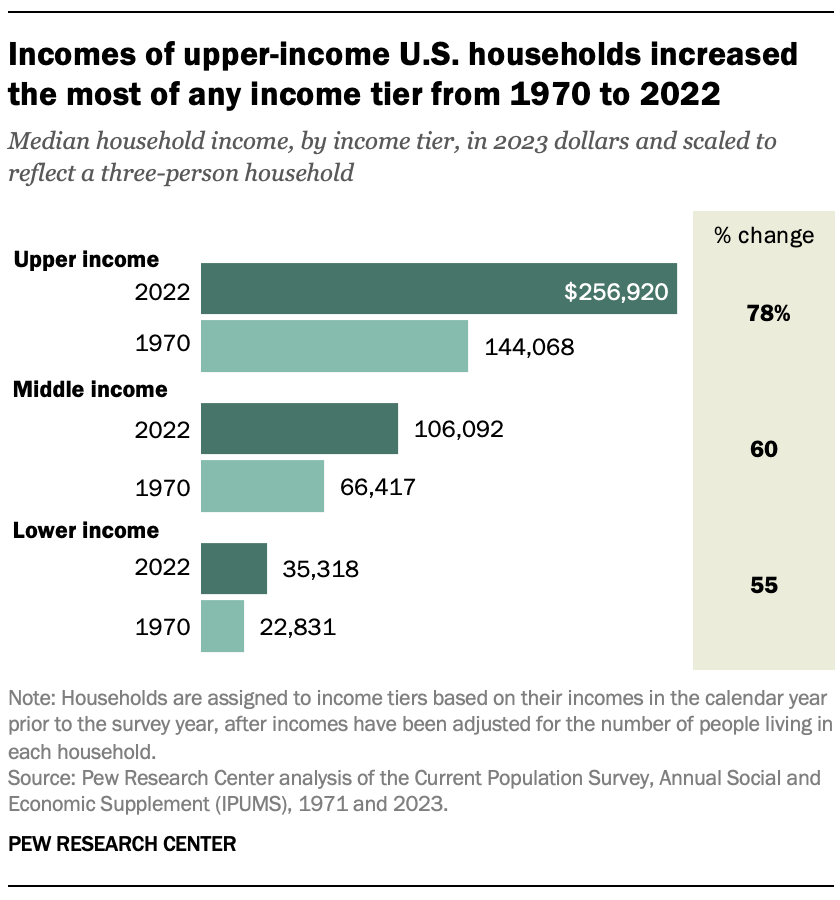
The median income of middle-class households increased from about $66,400 in 1970 to $106,100 in 2022, or 60%. Over this period, the median income of upper-income households increased 78%, from about $144,100 to $256,900. (Incomes are scaled to a three-person household and expressed in 2023 dollars.)
The median income of lower-income households grew more slowly than that of other households, increasing from about $22,800 in 1970 to $35,300 in 2022, or 55%.
Consequently, there is now a larger gap between the incomes of upper-income households and other households. In 2022, the median income of upper-income households was 7.3 times that of lower-income households, up from 6.3 in 1970. It was 2.4 times the median income of middle-income households in 2022, up from 2.2 in 1970.
The share of total U.S. household income held by the middle class has fallen almost without fail in each decade since 1970 . In that year, middle-income households accounted for 62% of the aggregate income of all U.S. households, about the same as the share of people who lived in middle-class households.
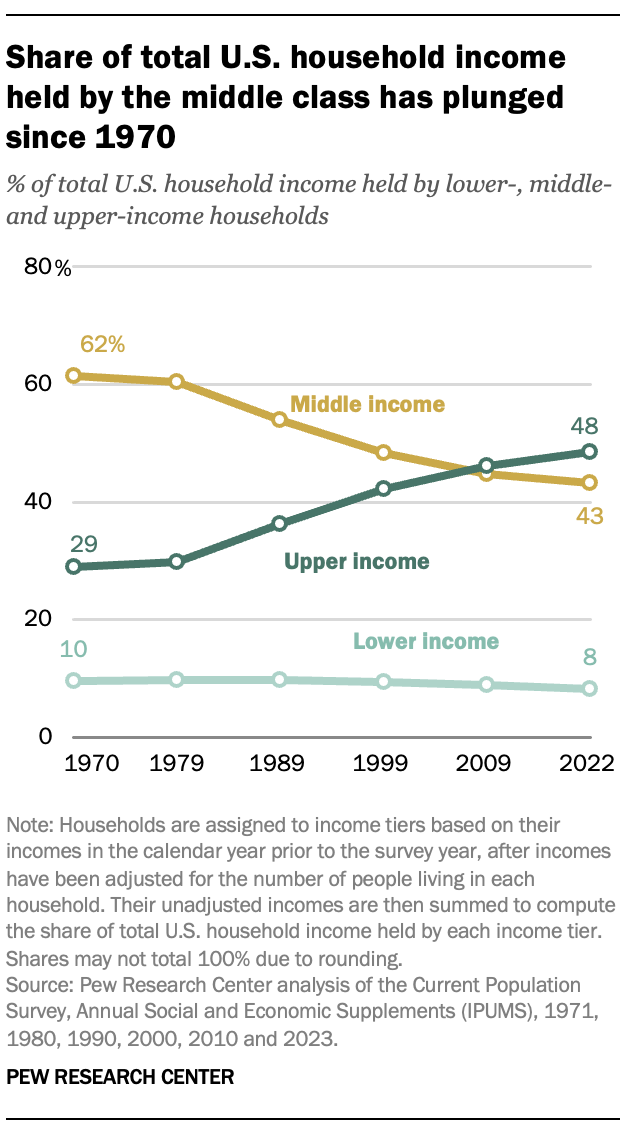
By 2022, the middle-class share in overall household income had fallen to 43%, less than the share of the population in middle-class households (51%). Not only do a smaller share of people live in the middle class today, the incomes of middle-class households have also not risen as quickly as the incomes of upper-income households.
Over the same period, the share of total U.S. household income held by upper-income households increased from 29% in 1970 to 48% in 2022. In part, this is because of the increase in the share of people who are in the upper-income tier.
The share of overall income held by lower-income households edged down from 10% in 1970 to 8% in 2022. This happened even though the share of people living in lower-income households increased over this period.
The share of people in the U.S. middle class varied from 46% to 55% across racial and ethnic groups in 2022. Black and Hispanic Americans, Native Hawaiians or Pacific Islanders, and American Indians or Alaska Natives were more likely than others to be in lower-income households .
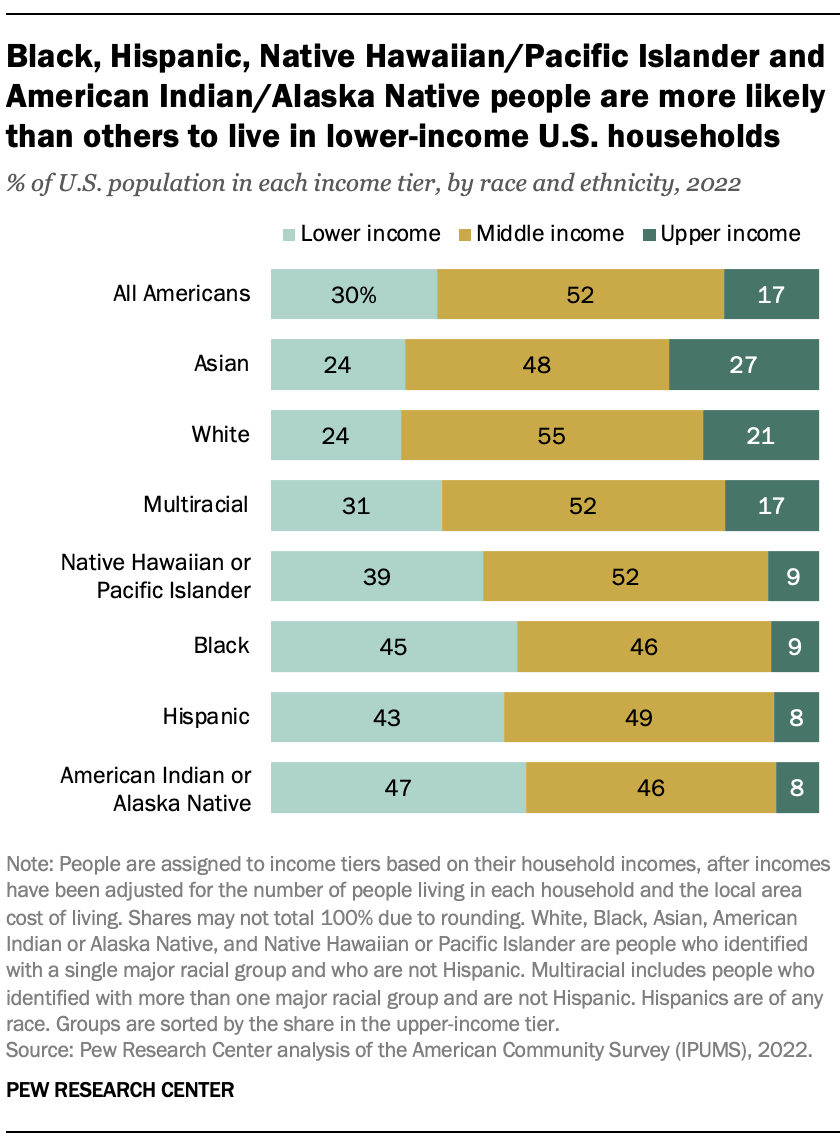
In 2022, 39% to 47% of Americans in these four groups lived in lower-income households. In contrast, only 24% of White and Asian Americans and 31% of multiracial Americans were in the lower-income tier.
At the other end of the economic spectrum, 27% of Asian and 21% of White Americans lived in upper-income households in 2022, compared with about 10% or less of Black and Hispanic Americans, Native Hawaiians or Pacific Islanders, and American Indians or Alaska Natives.
Not surprisingly, lower-income status is correlated with the likelihood of living in poverty. According to the Census Bureau , the poverty rate among Black (17.1%) and Hispanic (16.9%) Americans and American Indians or Alaska Natives (25%) was greater than the rate among White and Asian Americans (8.6% for each). (The Census Bureau did not report the poverty rate for Native Hawaiians or Pacific Islanders.)
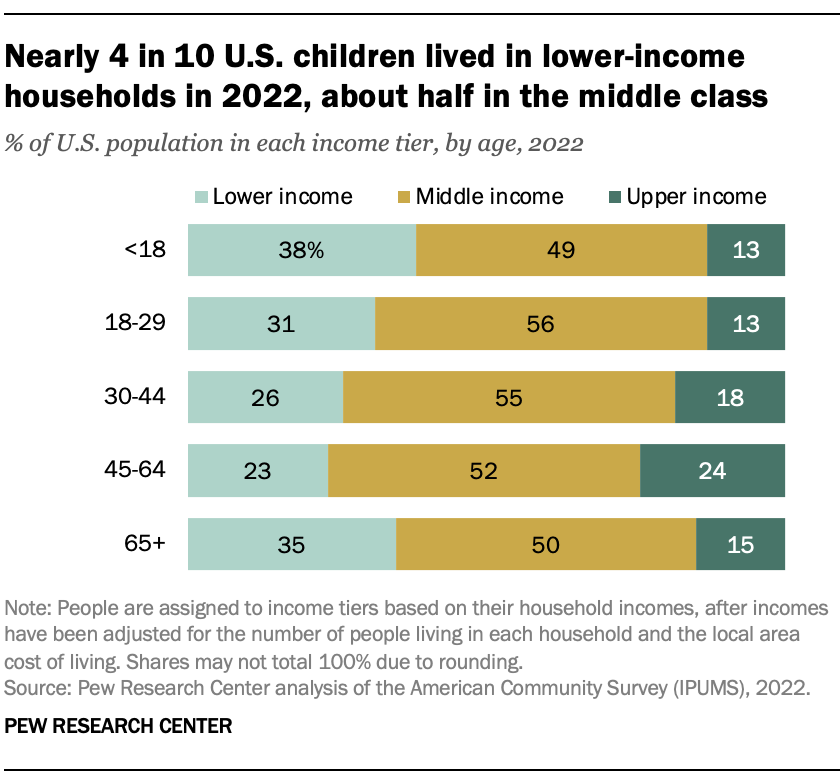
Children and adults 65 and older were more likely to live in lower-income households in 2022. Adults in the peak of their working years – ages 30 to 64 – were more likely to be upper income. In 2022, 38% of children (including teens) and 35% of adults 65 and older were lower income, compared with 26% of adults ages 30 to 44 and 23% of adults 45 to 64.
The share of people living in upper-income households ranged from 13% among children and young adults (up to age 29) to 24% among those 45 to 64. In each age group, about half or a little more were middle class in 2022.
Men were slightly more likely than women to live in middle-income households in 2022 , 53% vs. 51%. Their share in upper-income households (18%) was also somewhat greater than the share of women (16%) in upper-income households.
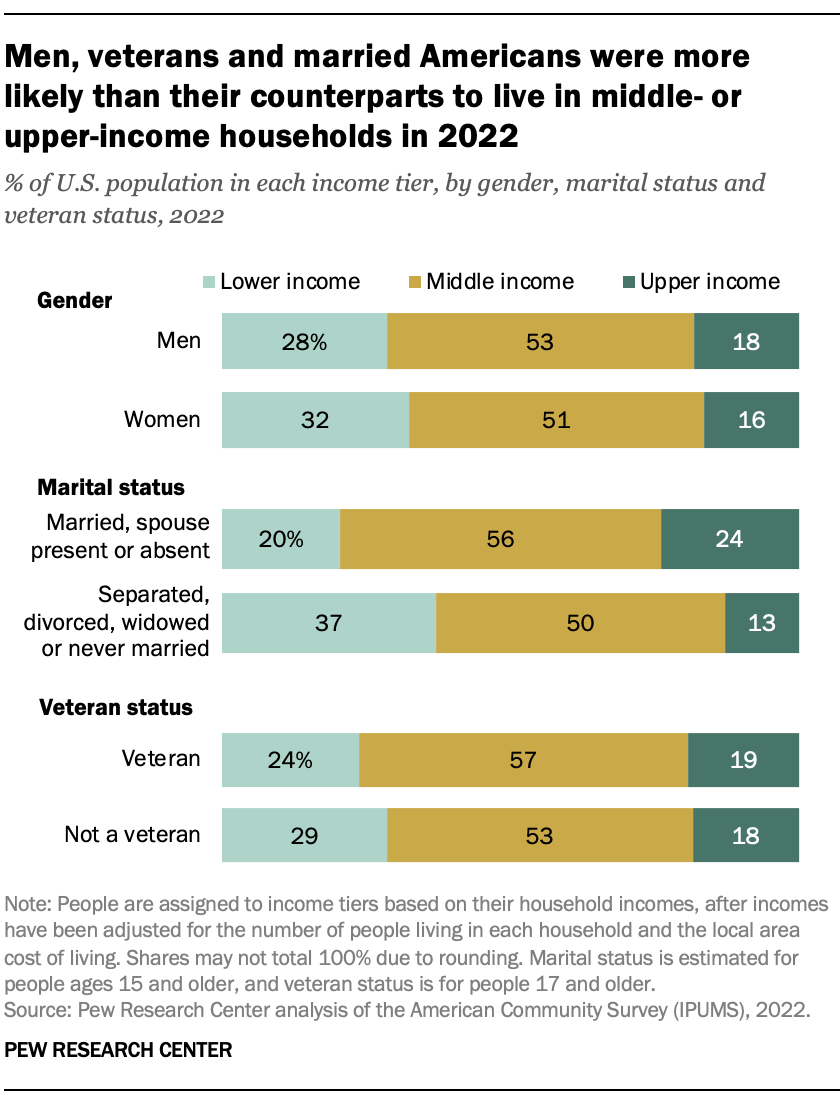
Marriage appears to boost the economic status of Americans. Among those who were married in 2022, eight-in-ten lived either in middle-income households (56%) or upper-income households (24%). In contrast, only about six-in-ten of those who were separated, divorced, widowed or never married were either middle class or upper income, while 37% lived in lower-income households.
Veterans were more likely than nonveterans to be middle income in 2022, 57% vs. 53%. Conversely, a higher share of nonveterans (29%) than veterans (24%) lived in lower-income households.
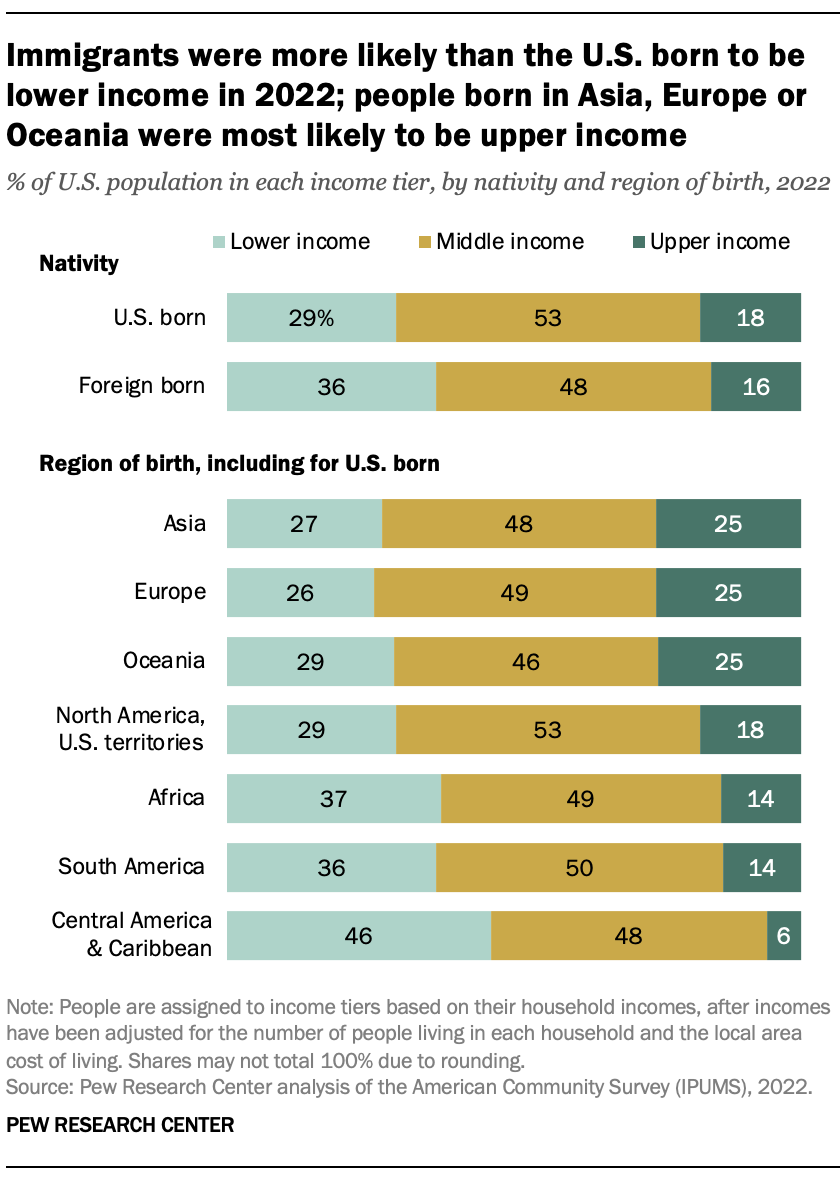
Immigrants – about 14% of the U.S. population in 2022 – were less likely than the U.S. born to be in the middle class and more likely to live in lower-income households. In 2022, more than a third of immigrants (36%) lived in lower-income households, compared with 29% of the U.S. born. Immigrants also trailed the U.S. born in the shares who were in the middle class, 48% vs. 53%.
There are large gaps in the economic status of American residents by their region of birth. Among people born in Asia, Europe or Oceania, 25% lived in upper-income households in 2022. People from these regions represented 7% of the U.S. population.
By comparison, only 14% of people born in Africa or South America and 6% of those born in Central America and the Caribbean were in the upper-income tier in 2022. Together they accounted for 8% of the U.S. population.
The likelihood of being in the middle class or the upper-income tier varies considerably with the ancestry of Americans. In 2022, Americans reporting South Asian ancestry were about as likely to be upper income (38%) as they were to be middle income (42%). Only 20% of Americans of South Asian origin lived in lower-income households. South Asians accounted for about 2% of the U.S. population of known origin groups in 2022.
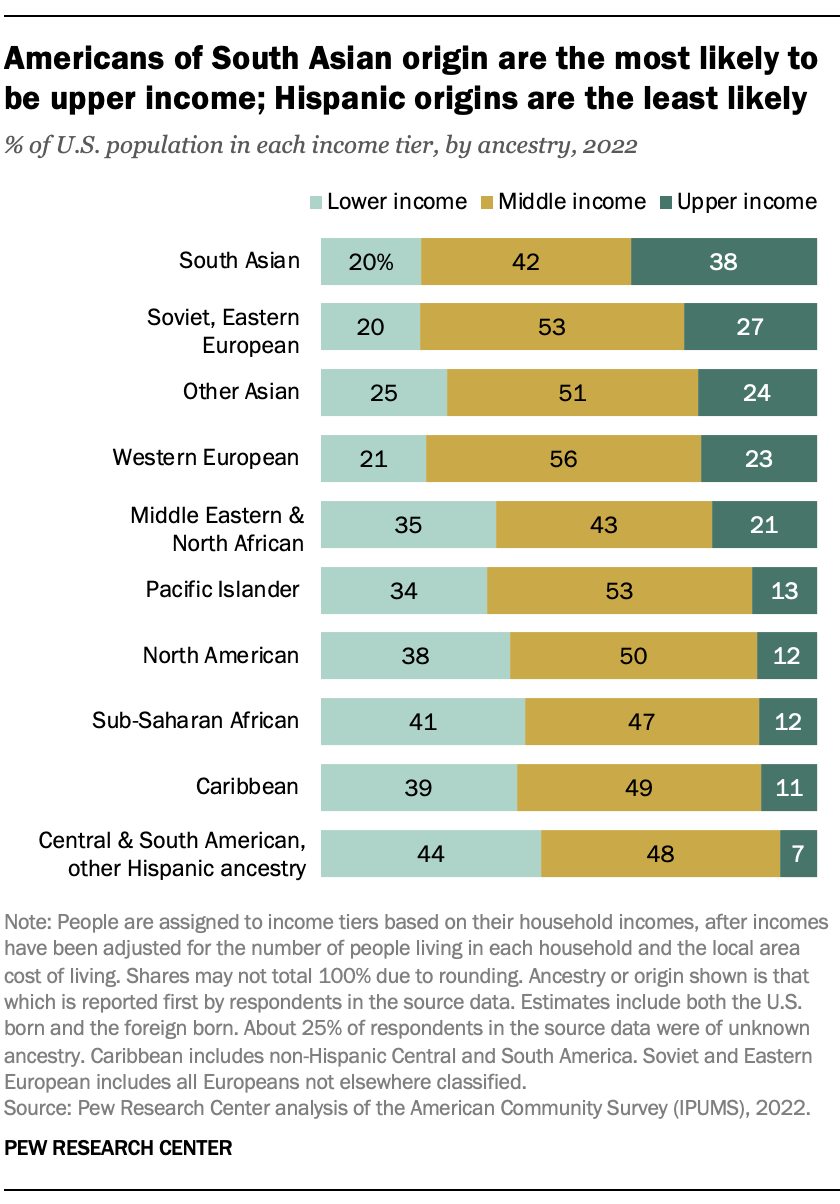
At least with respect to the share who were lower income, this was about matched by those with Soviet, Eastern European, other Asian or Western European origins. These groups represented the majority (54%) of the population of Americans whose ancestry was known in 2022.
On the other hand, only 7% of Americans with Central and South American or other Hispanic ancestry were in the upper-income tier, and 44% were lower income. The economic statuses of Americans with Caribbean, sub-Saharan African or North American ancestry were not very different from this.
Education matters for moving into the middle class and beyond, and so do jobs. Among Americans ages 25 and older in 2022, 52% of those with a bachelor’s degree or higher level of education lived in middle-class households and another 35% lived in upper-income households.
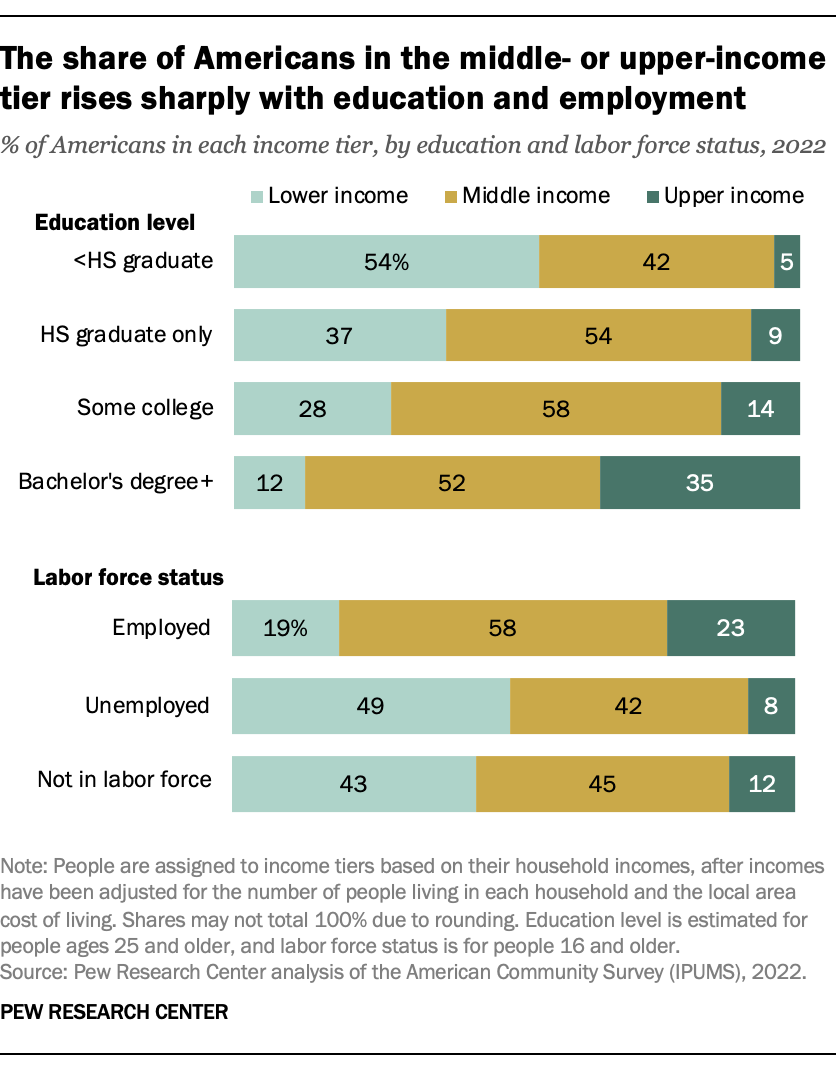
In sharp contrast, 42% of Americans who did not graduate from high school were in the middle class, and only 5% were in the upper-income tier. Further, only 12% of college graduates were lower income, compared with 54% of those who did not complete high school.
Not surprisingly, having a job is strongly linked to movement from the lower-income tier to the middle- and upper-income tiers. Among employed American workers ages 16 and older, 58% were in the middle-income tier in 2022 and 23% were in the upper-income tier. Only 19% of employed workers were lower income, compared with 49% of unemployed Americans.
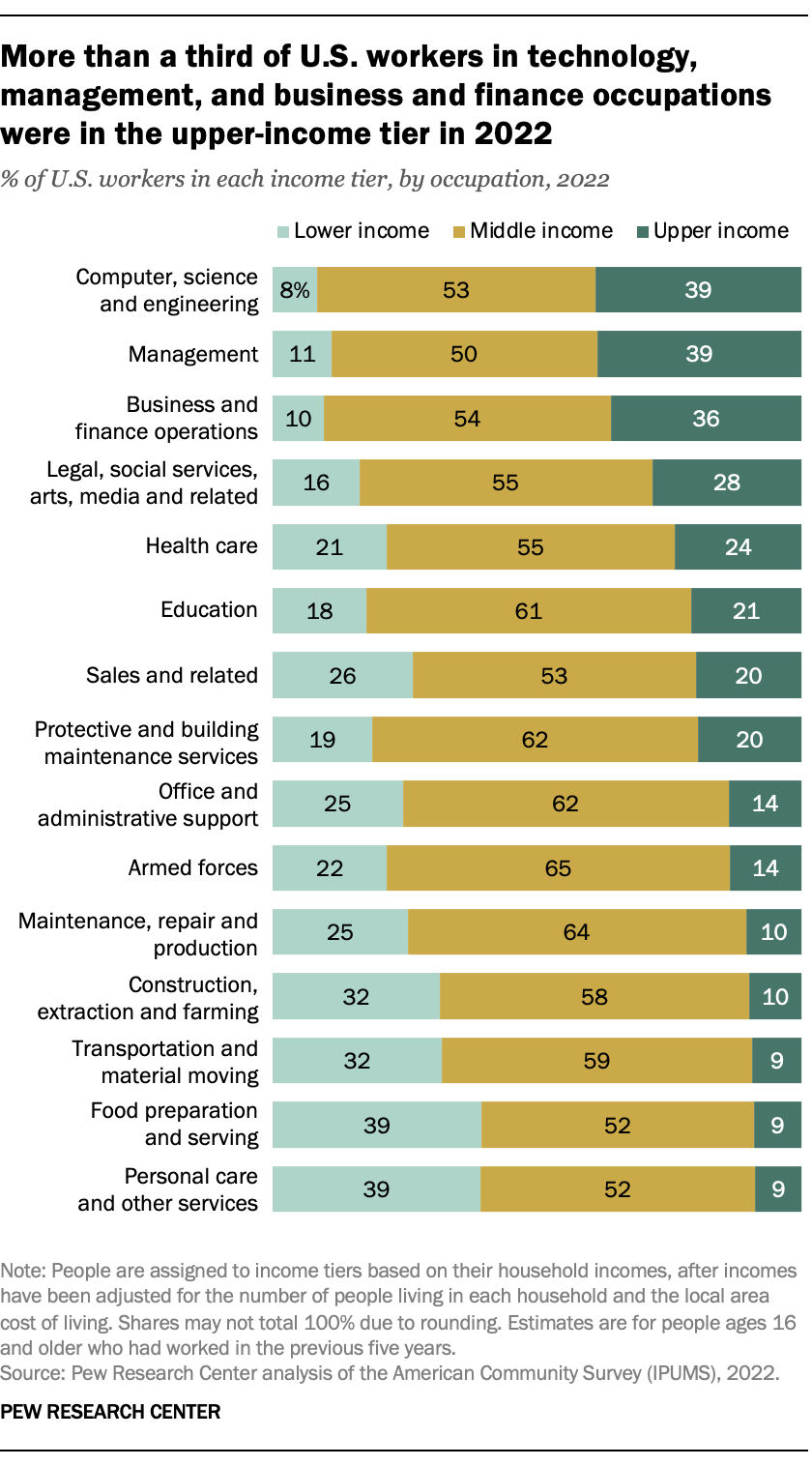
In some occupations, about nine-in-ten U.S. workers are either in the middle class or in the upper-income tier, but in some other occupations almost four-in-ten workers are lower income. More than a third (36% to 39%) of workers in computer, science and engineering, management, and business and finance occupations lived in upper-income households in 2022. About half or more were in the middle class.
But many workers – about one-third or more – in construction, transportation, food preparation and serving, and personal care and other services were in the lower-income tier in 2022.
About six-in-ten workers or more in education; protective and building maintenance services; office and administrative support; the armed forces; and maintenance, repair and production were in the middle class.
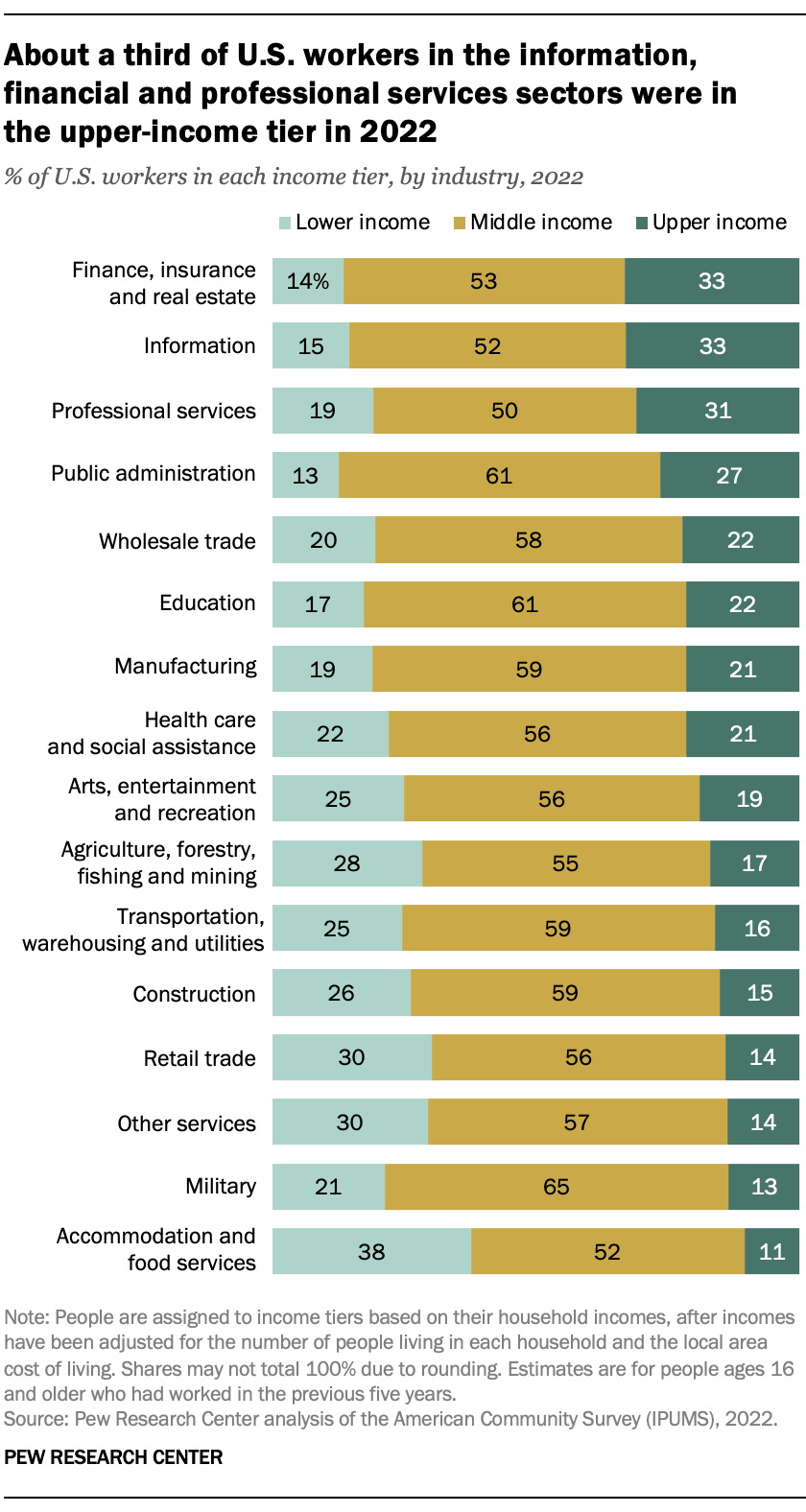
Depending on the industrial sector, anywhere from half to two-thirds of U.S. workers were in the middle class, and the share who are upper income or lower income varied greatly.
About a third of workers in the finance, insurance and real estate, information, and professional services sectors were in the upper-income tier in 2022. Nearly nine-in-ten workers (87%) in public administration – largely filling legislative functions and providing federal, state or local government services – were either in the middle class or the upper-income tier.
But nearly four-in-ten workers (38%) in accommodation and food services were lower income in 2022, along with three-in-ten workers in the retail trade and other services sectors.
The share of Americans who are in the middle class or in the upper- or lower-income tier differs across U.S. metropolitan areas. But a pattern emerges when it comes to which metro areas have the highest shares of people living in lower-, middle- or upper-income households. (We first adjust household incomes for differences in the cost of living across areas.)
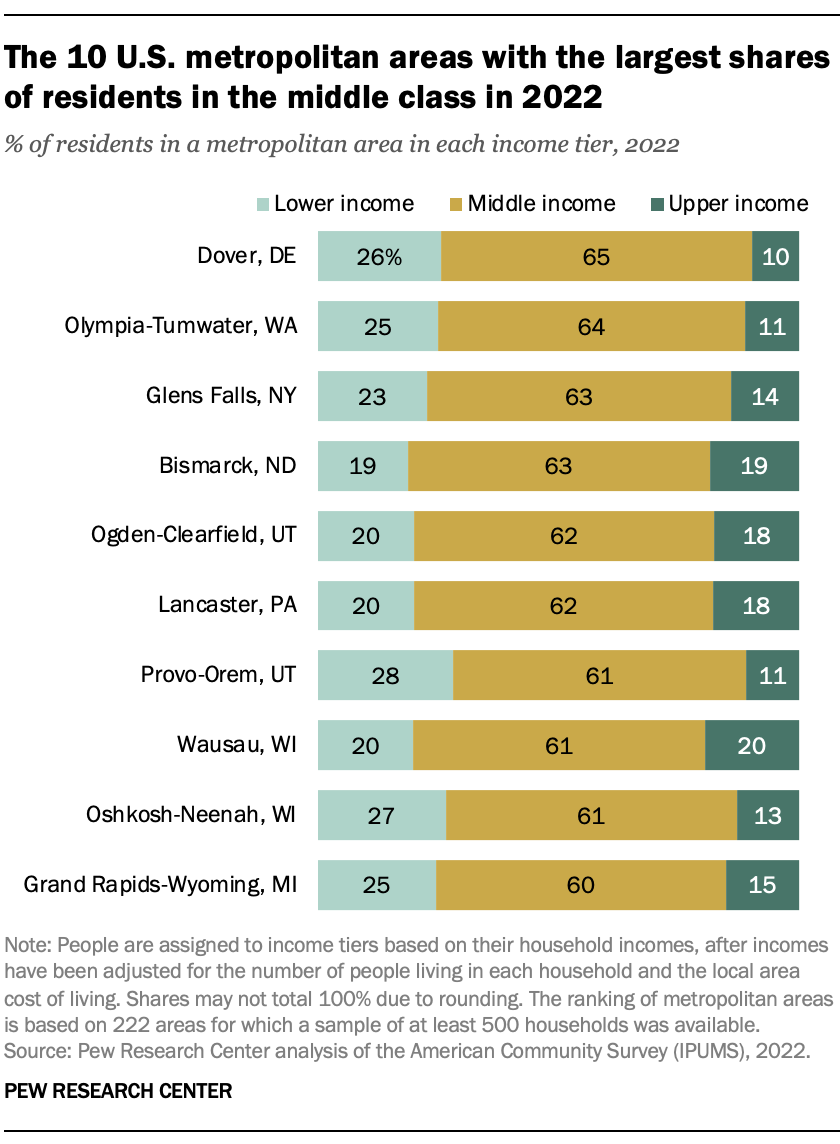
The 10 metropolitan areas with the greatest shares of middle-income residents are small to midsize in population and are located mostly in the northern half of the U.S. About six-in-ten residents in these metro areas were in the middle class.
Several of these areas are in the so-called Rust Belt , namely, Wausau and Oshkosh-Neenah, both in Wisconsin; Grand Rapids-Wyoming, Michigan; and Lancaster, Pennsylvania. Two others – Dover and Olympia-Tumwater – include state capitals (Delaware and Washington, respectively).
In four of these areas – Bismarck, North Dakota, Ogden-Clearfield, Utah, Lancaster and Wausau – the share of residents in the upper-income tier ranged from 18% to 20%, about on par with the share nationally.
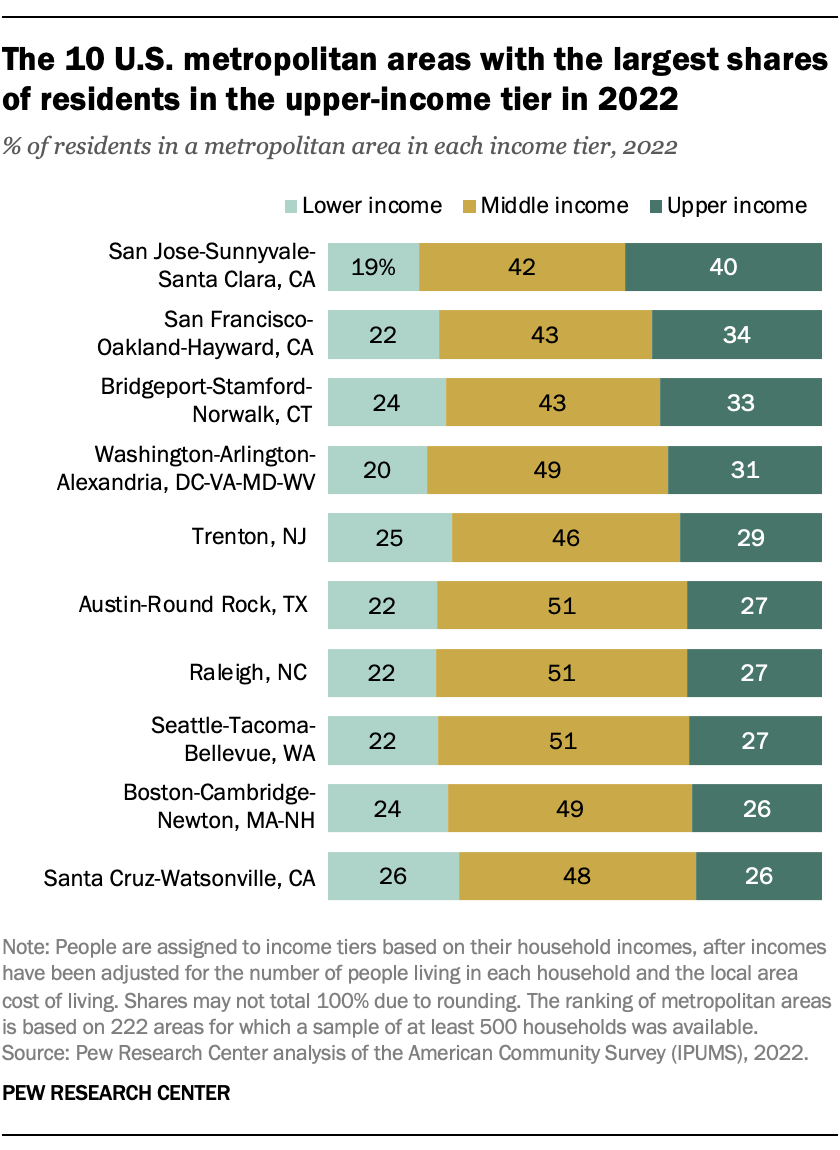
The 10 U.S. metropolitan areas with the highest shares of residents in the upper-income tier are mostly large, coastal communities. Topping the list is San Jose-Sunnyvale-Santa Clara, California, a technology-driven economy, in which 40% of the population lived in upper-income households in 2022. Other tech-focused areas on this list include San Francisco-Oakland-Hayward; Seattle-Tacoma-Bellevue; and Raleigh, North Carolina.
Bridgeport-Stamford-Norwalk, Connecticut, is a financial hub. Several areas, including Washington, D.C.-Arlington-Alexandria and Boston-Cambridge-Newton, are home to major universities, leading research facilities and the government sector.
Notably, many of these metro areas also have sizable lower-income populations. For instance, about a quarter of the populations in Bridgeport-Stamford-Norwalk; Trenton, New Jersey; Boston-Cambridge-Newton; and Santa Cruz-Watsonville, California, were in the lower-income tier in 2022.
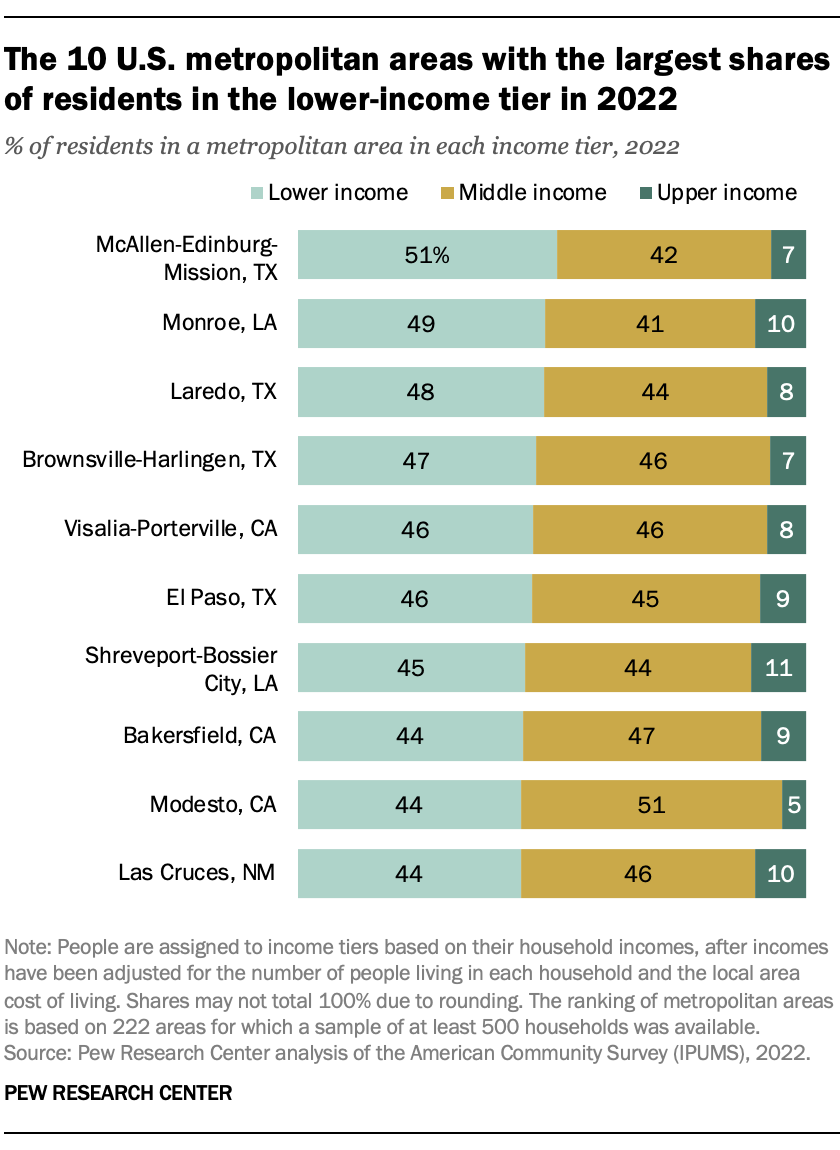
Most of the 10 U.S. metropolitan areas with the highest shares of residents in the lower-income tier are in the Southwest, either on the southern border of Texas or in California’s Central Valley. The shares of people living in lower-income residents were largely similar across these areas, ranging from about 45% to 50%.
About 40% to 50% of residents in these metro areas were in the middle class, and only about one-in-ten or fewer lived in upper-income households.
Compared with the nation overall, the lower-income metro areas in Texas and California have disproportionately large Hispanic populations. The two metro areas in Louisiana – Monroe and Shreveport-Bossier City – have disproportionately large Black populations.
Note: For details on how this analysis was conducted, refer to the methodology .
Sign up for our weekly newsletter
Fresh data delivery Saturday mornings
Sign up for The Briefing
Weekly updates on the world of news & information
- Income, Wealth & Poverty
- Middle Class
The State of the Asian American Middle Class
Black and hispanic americans, those with less education are more likely to fall out of the middle class each year, how the american middle class has changed in the past five decades, covid-19 pandemic pinches finances of america’s lower- and middle-income families, are you in the global middle class find out with our income calculator, most popular, report materials.
- Methodology
1615 L St. NW, Suite 800 Washington, DC 20036 USA (+1) 202-419-4300 | Main (+1) 202-857-8562 | Fax (+1) 202-419-4372 | Media Inquiries
Research Topics
- Email Newsletters
ABOUT PEW RESEARCH CENTER Pew Research Center is a nonpartisan fact tank that informs the public about the issues, attitudes and trends shaping the world. It conducts public opinion polling, demographic research, media content analysis and other empirical social science research. Pew Research Center does not take policy positions. It is a subsidiary of The Pew Charitable Trusts .
© 2024 Pew Research Center

Where to find Syracuse, CNY lacrosse players in Premiere Lacrosse League as 2024 season begins
Syracuse, N.Y. —The Premier Lacrosse League is set to begin its sixth season in Albany, N.Y. on Saturday.
Six former Syracuse University players are on opening day rosters for Week One of the 2024 season with one on the PUP list and another listed as unable to travel.
The PLL also has six former high school stars from Section III dotting its rosters.
Here is a list of where you can find former Orange and CNY players in the league:
Charlie Bertrand
Bertrand, a Baldwinsville alum who played his college lacrosse at Virginia and Merrimack, enters his fourth season as a midfielder with the California Redwoods.
He has 48 career points in the PLL. He was named a 2nd-team All Pro in 2022.
Tucker Dordevic
Dordevic, the 2023 PLL rookie of the year , finished last season with 26 points at midfield. He starts the 2024 season on the PUP (physically unable to perform) list for the Maryland Whipsnakes.
Dordevic collected 124 points on 95 goals and 29 assists in 47 games with the Orange before finishing his career at Georgetown.
Marcus Hudgins
West Genesee alum Marcus Hudgins was selected 23rd overall by the Philadelphia Waterdogs in the 2024 PLL draft.
He was named a First Team All-Big Ten honoree this season, leading the Buckeyes with 22 caused turnovers. He started all 15 games for the Buckeyes this year and added a career-high 48 ground balls, three assists and one goal.
Hudgins is listed on the Watersdogs’ protected roster to begin the season.
Brett Kennedy
Kennedy enters his third season in the PLL as a long-stick midfielder. It’s his second season with the Maryland Whipsnakes. He also played for Carolina Chaos in 2022. In eight career games, Kennedy has 15 ground balls and five caused turnovers.
Kirst had a strong rookie season at midfield, collecting 18 points (13g, 5a) for the California Redwoods. Kirst quickly developed a strong reputation in the league and was honored as the Teammate of the Year in the PLL last year.
Mark was a surprising omission from the PLL Draft but made the Maryland Whipsnakes opening day roster. He’ll be one of three goaltenders for the Whipsnakes to start the 2024 season.
Mark finished his Syracuse career with 20 wins, 412 saves and a .533 career save percentage. He also played three seasons as a goalie at Long Island University where he made 499 career saves.
Jacob Morin
Morin, an Auburn native who just completed his college career at Army, is on the protected roster of the Utah Archers as a midfielder.
Morin was a unanimous All-American and first team All-Patriot League with 27 goals for the Black Knights.
Joseph Nardella
Nardella, a Cazenovia alum who played his college lacrosse at Rutgers, is entering his sixth season as a FOGO with the Maryland Whipsnakes. He is a four-time PLL All-Star who has played in 82 career games. Nardella has a 58% winning percentage on face-offs, has grabbed 649 ground balls and scored 66 career points.
Olexo went undrafted but made the roster for the Denver Outlaws at LSM. A versatile defenseman who can play short-stick, long pole or LSM, Olexo had 43 caused turnovers, 107 ground balls, eight goals and three assists in 38 career games for the Orange.
Jake Piseno
Piseno, a long-stick midfielder, was recently drafted by the Denver Outlaws in the second round, ninth overall, of the 2024 draft.
Piseno, a Liverpool alum, recently completed his career with Albany, where he established himself as one of the country’s best defenders. He finished with 44 caused turnover and snared 79 ground balls.
Drake Porter
Porter finds himself in a battle for the backup goalie position for the New York Atlas along with Tim Troutner behind presumed starter Liam Entenmann, the rookie from Notre Dame coming off back-to-back national titles with the Irish.
Porter has played in three career games for the Atlas, making 22 saves.
Jake Pulver
Pulver, a Fayetteville-Manlius graduate who played his college lacrosse at Cornell, enters his sixth season in the PLL, This will be his fourth season with the Boston Cannons as a defenseman.
Pulver is a two-time PLL All-Star who has 66 caused turnovers and 90 ground balls in his pro career.
He was a three-time All-Ivy defender and ranked eighth all time in Cornell history for caused turnovers
Alex Simmons
Simmons begins his rookie year in the PLL with the California Redwoods coming off being named the Rookie of the Year in the NLL (indoor lacrosse) with the Albany FireWolves.
Simmons started all 15 games as a graduate student attack with Syracuse in 2023, finishing with 36 points on 21 goals and 15 assists. He played in 50 career games at University of Denver, scoring 129 points with the Pioneers.
Jake Stevens
Stevens was selected 10th overall in the Premiere Lacrosse League Draft by the New York Atlas but begins the season listed as unable to travel.
Stevens added some needed experience and punch to the Orange midfield this season after transferring from Princeton. He had 32 points (17g, 15a) for the Orange this season. Stevens spent four seasons at Princeton, recording 58 goals and 11 assists before transferring to Syracuse.
Contact Brent Axe: Email | X | Voicemail 315-552-1964
©2024 Advance Local Media LLC. Visit syracuse.com. Distributed by Tribune Content Agency, LLC.


COMMENTS
October 22, 2022 6:00 AM ET. Emily Feng ... Chinese demand for surrogacy and birth tourism services was so high he used to rent out entire apartment buildings for Chinese families.
Giving birth in the U.S. on a tourist visa can have certain legal consequences for both mother and child. 1. Legal Implications For The Mother. Giving birth in the U.S. on a tourist visa does not automatically grant you the right to stay in the country based on the birth of your child. Your visa status remains unchanged and you will be ...
Committee on Homeland Security & Governmental Affairs
Effective January 24, the Department is amending its B nonimmigrant visa regulation to address birth tourism.Under this amended regulation, U.S. consular officers overseas will deny any B visa application from an applicant whom the consular officer has reason to believe is traveling for the primary purpose of giving birth in the United States to obtain U.S. citizenship for their child.
Published 1:03 PM PDT, January 23, 2020. WASHINGTON (AP) — The Trump administration is imposing new visa rules aimed at restricting "birth tourism," in which women travel to the United States to give birth so their children can have U.S. citizenship. The regulations, which take effect Friday, address one of President Donald Trump's main ...
The Center for Immigration Studies say they estimate that there are 33,000 births annually as a result of birth tourism in the US. They also say that the most common countries people travel from for birth tourism are China, Taiwan, Korea, Nigeria, Turkey, Russia, Brazil, and Mexico. Brazil. People also travel to Brazil for birth tourism purposes.
The White House says birth tourism is putting additional pressure on hospital resources. In a statement this week, press secretary Stephanie Grisham said the new ban would "defend American ...
British Columbia's Richmond Hospital was once the epicentre of birth tourism with its supportive "cottage industry" of "birth hotels." In 2019-20, non-resident mothers made up 24 per cent of its births. But it fell sharply in this category during the pandemic and has rebounded only to four per cent in 2022. It's now fourth in the ...
Birth Tourism in the United States - Committee on Homeland Security & Governmental Affairs.
This provides a very good indication of the extent of birth tourism in Canada. Now that the restrictions are loosening and travel is once again opening up, it's time for the federal government to revisit its policy on non-resident births and Canadian citizenship. The decline to 2,245 in 2021 from 2,433 in 2020 occurred in all provinces save ...
The State Department has announced new rules to address birth tourism, which is the controversial practice of entering the United States to give birth so that the child will acquire U.S. citizenship. The prevailing interpretation of the 14th Amendment to the U.S. Constitution granting nearly all those born here U.S. citizenship (and the ability to pass it on to their children and to sponsor ...
The government has called this plan "baby tourism" that parents often want to carry out. Starting in January 2020, immigration officers can deny tourist visas to pregnant women suspected of entering the United States with the sole purpose of giving birth in this country. During the appointment, women must demonstrate different types of ...
S. 17. To amend the Immigration and Nationality Act to provide for inadmissibility for certain aliens seeking citizenship for children by giving birth in the United States, and for other purposes. IN THE SENATE OF THE UNITED STATES. January 22, 2021. Mrs. Blackburn introduced the following bill; which was read twice and referred to the ...
When it comes to determining a child's citizenship at birth, countries usually apply one of two rights: jus soli (right of soil) or jus sanguinis (right of blood). Jus soli grants citizenship merely on the basis of being born "on the soil" of the country in question. Jus sanguinis determines the child's citizenship based on the parents ...
In the fall of 2019, Cathy Shi arrived in Richmond, B.C., from Shandong, on China's east coast, to give birth to her third child. She said through a translator that she wanted her unborn child to ...
This is part of an industry known as "birth tourism", in which a pregnant woman enters Canada to give birth to a child who will then automatically be given citizenship. They typically travel to Canada as a tourist, and either book hospital rooms, rent apartments, or "baby houses" for the birth. These numbers have been growing in recent ...
The federal government will work to implement the strategy under the leadership of the TPC and in partnership with the private sector, aiming toward an ambitious five-year goal of increasing American jobs by attracting and welcoming 90 million international visitors, who we estimate will spend $279 billion, annually by 2027.. The new National Travel and Tourism Strategy supports growth and ...
Data via the congress project . Jan 22, 2021. S. 17 (117th). A bill to amend the Immigration and Nationality Act to provide for inadmissibility of certain aliens seeking citizenship for children by giving birth in the United States, and for other purposes. In GovTrack.us, a database of bills in the U.S. Congress.
Yes, giving birth in the United States, also known as Birthright Citizenship or jus soli, is legal. It is a right guaranteed under the Fourteenth Amendment of the U.S. Constitution. The Fourteenth Amendment ensures that anyone born within the country's territory is granted citizenship, without considering the nationality of the parents.
The number of births to women in their early 20s declined by 2% from 2021 to 2022. The provisional birth rate for women aged 25-29 was 93.4 births per 1,000 women, up less than 1% from 2021. (93.0) (3,8,9). The number of births to women in their late 20s was down 1% from 2021 to 2022.
The preterm birth rate declined between 2021 and 2022. The percentage of newborns born preterm declined 1% from 10.49% of all births in 2021 to 10.38% in 2022. This decline follows a 4% rise in the preterm rate from 2020 (10.09%) to 2021 (Figure 4). The preterm birth rate declined 1% for Black mothers, from 14.75% in 2021 to 14.59% in 2022.
By Devika Rao, The Week US. published 21 May 2024. The U.S. fertility rate dropped to a record low in 2023. Birth rates have been declining for the last few decades, and Americans are currently ...
Births increased in only 15 states from 2021 to 2022, compared with growth in 43 states between 2020 and 2021. More detailed statistics, which could shift slightly, are due for release June 1.
The median income of middle-class households increased from about $66,400 in 1970 to $106,100 in 2022, or 60%. Over this period, the median income of upper-income households increased 78%, from about $144,100 to $256,900. (Incomes are scaled to a three-person household and expressed in 2023 dollars.)
Best Covid Travel Insurance Policies. Travel Insured - Worldwide Trip Protector. WorldTrips - Atlas Journey Premier/Atlas Journey Preferred. Seven Corners - Trip Protection Choice/Trip ...
He has 48 career points in the PLL. He was named a 2nd-team All Pro in 2022. Tucker Dordevic. Dordevic, the 2023 PLL rookie of the year, finished last season with 26 points at midfield.He starts ...
We analyzed 26 policies and found that PrimeCover and Seven Corners offer the best senior travel insurance, earning five out of five stars in our analysis. If delays and emergencies disrupt your ...